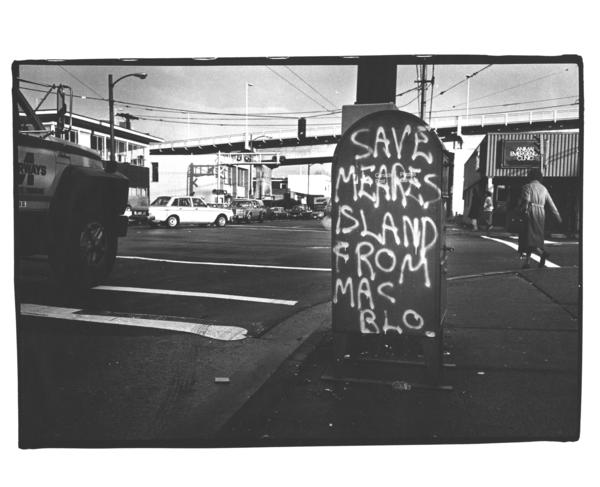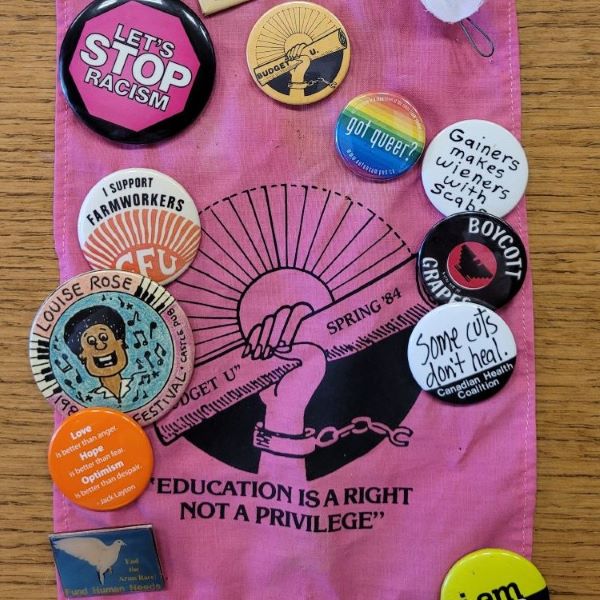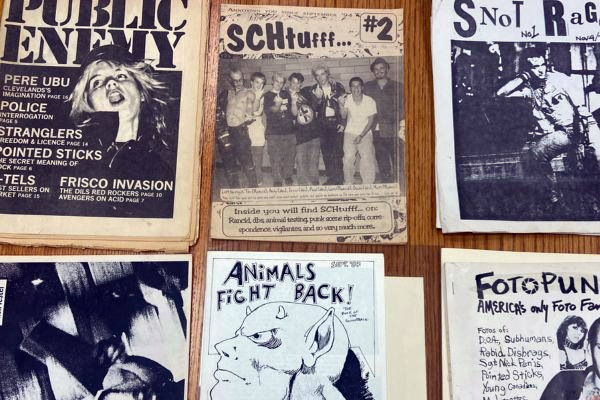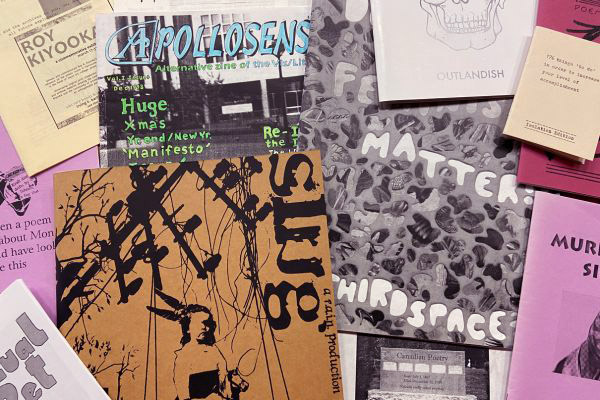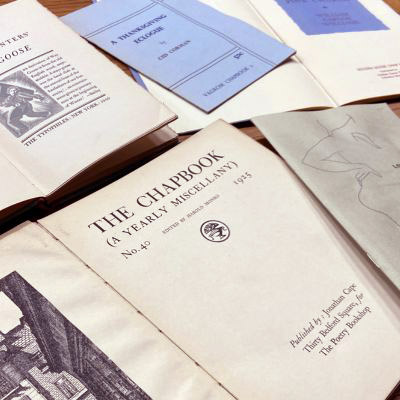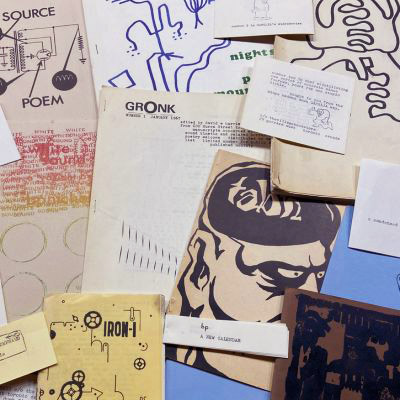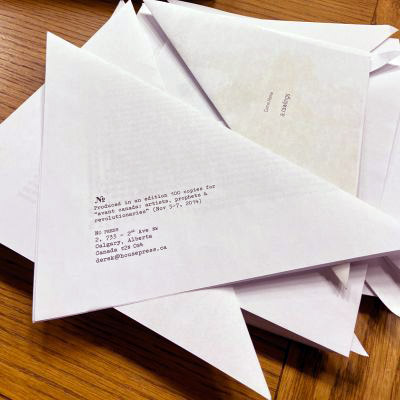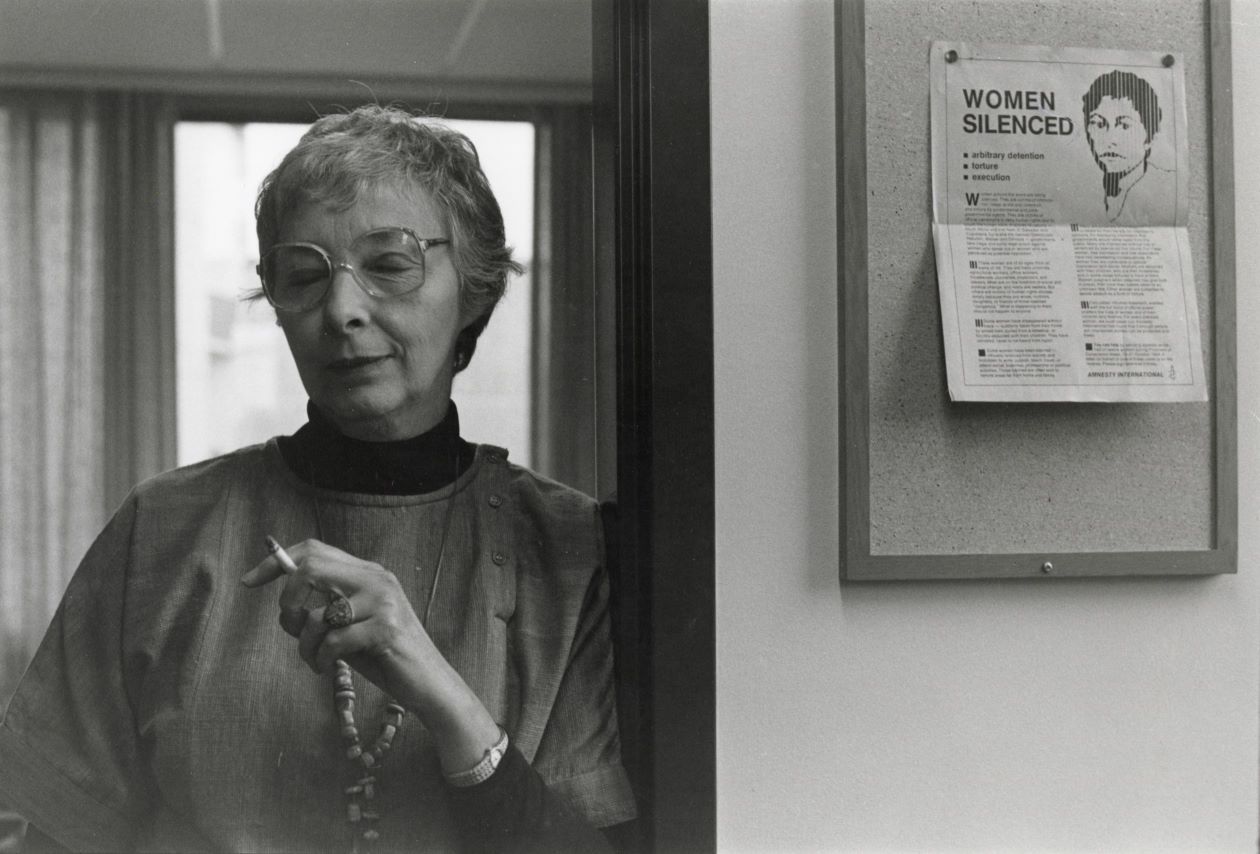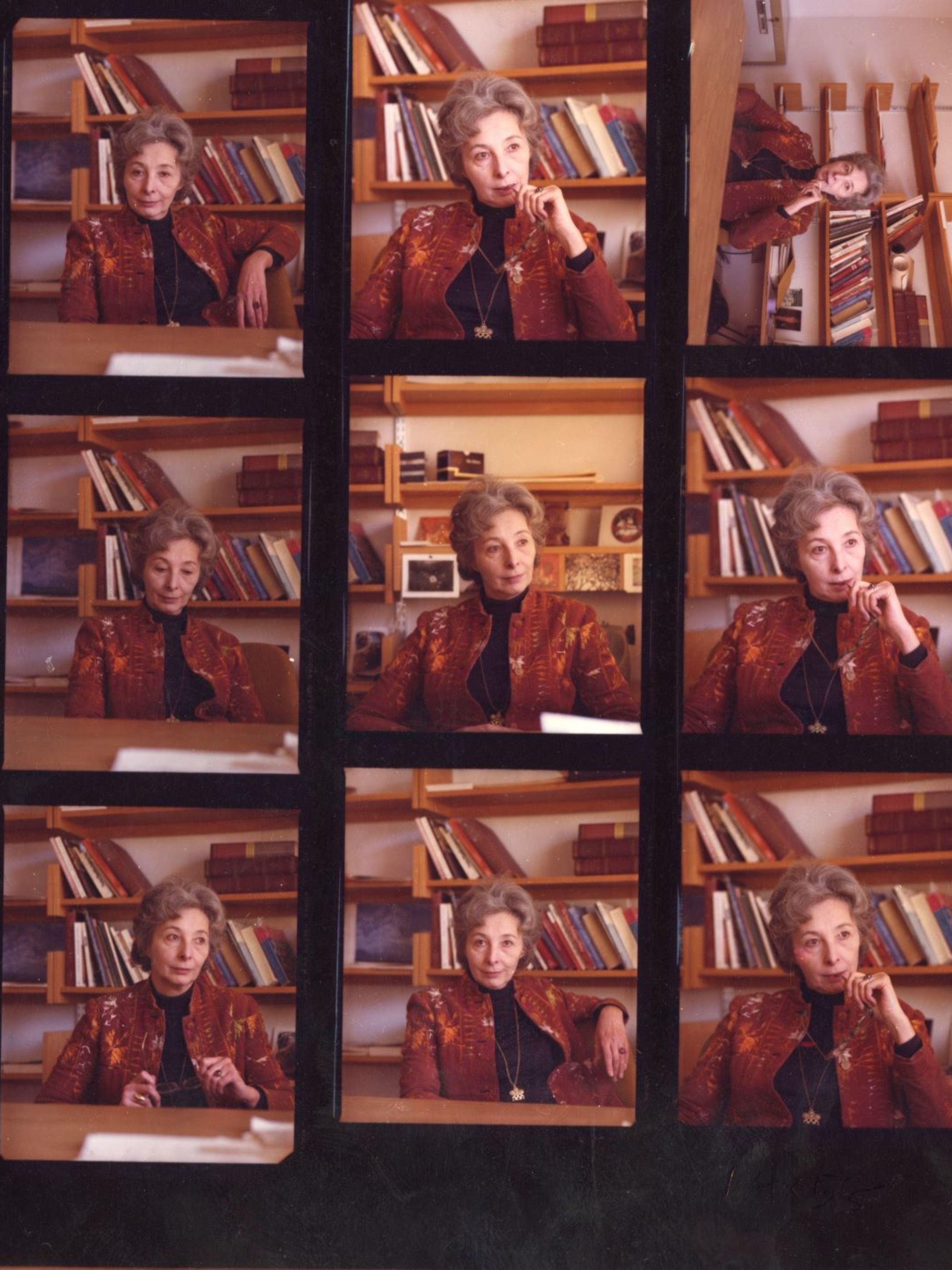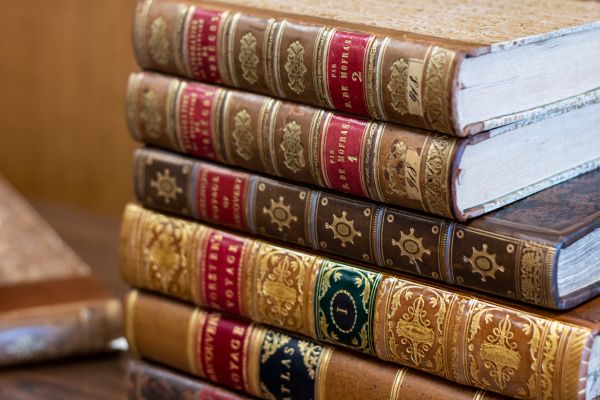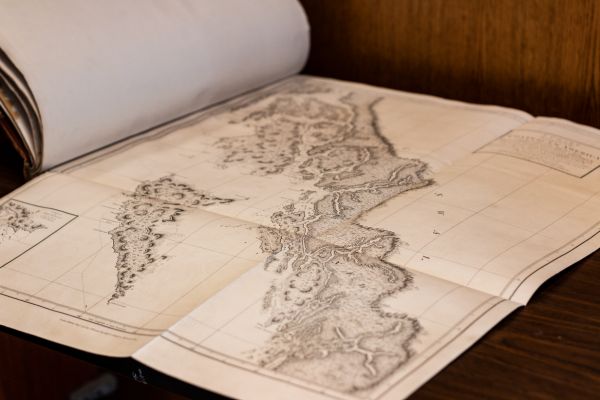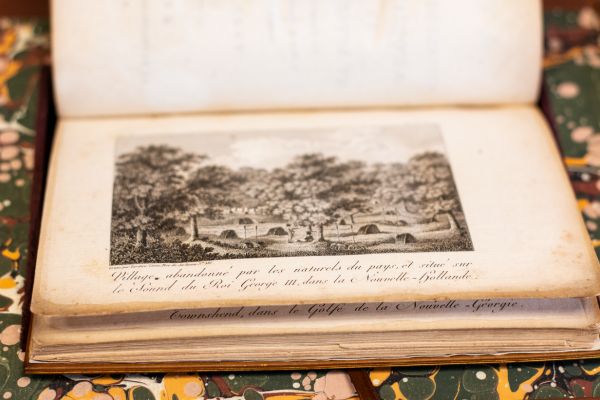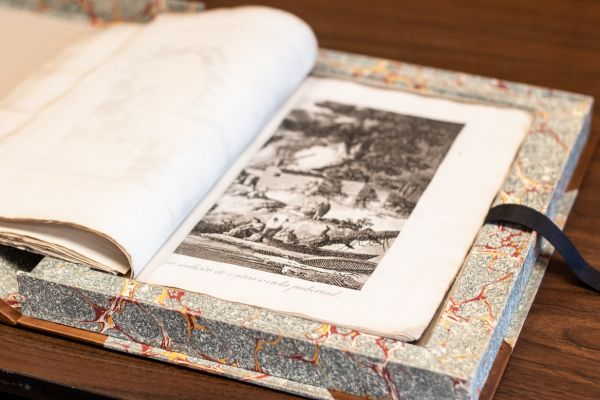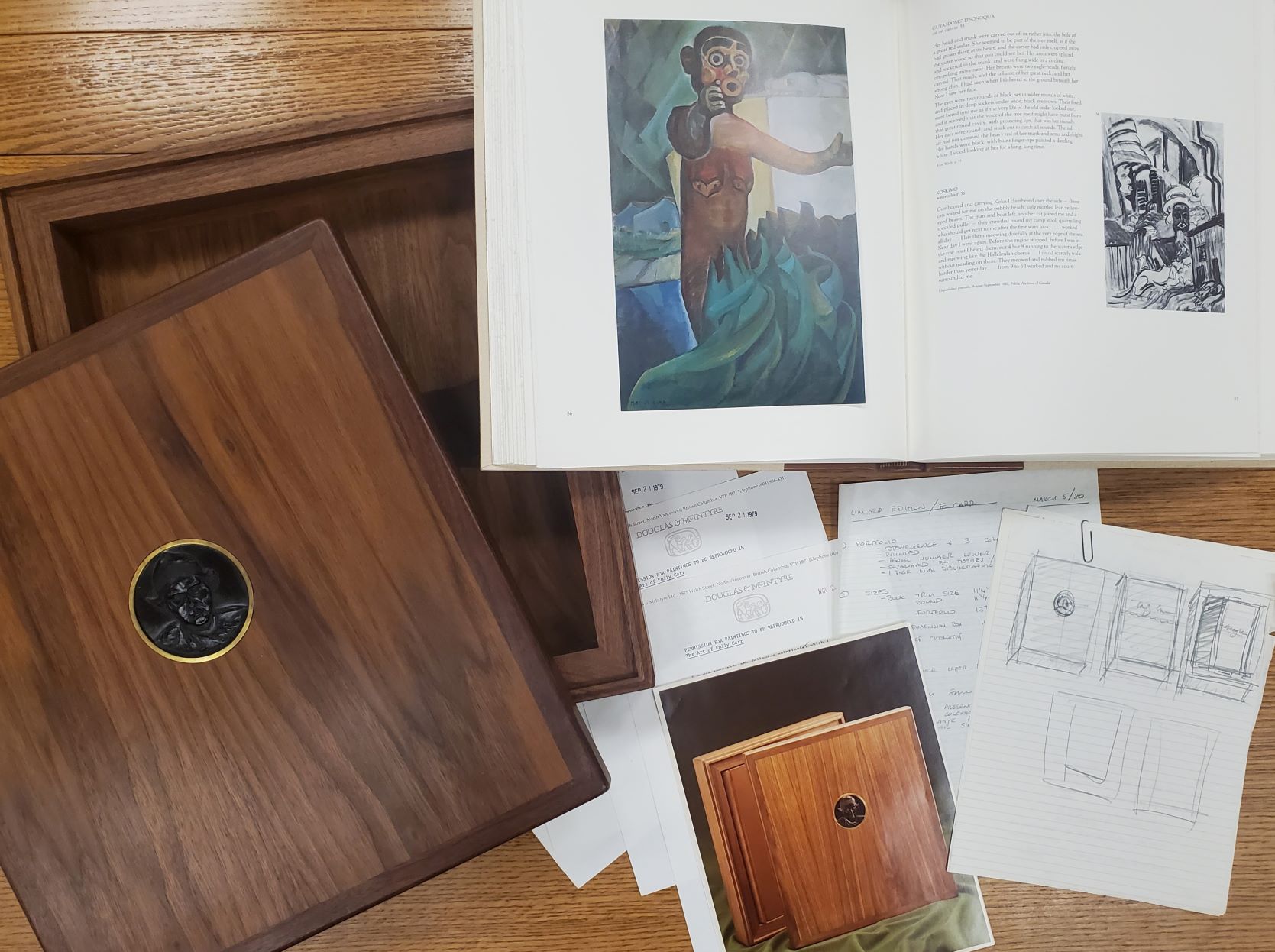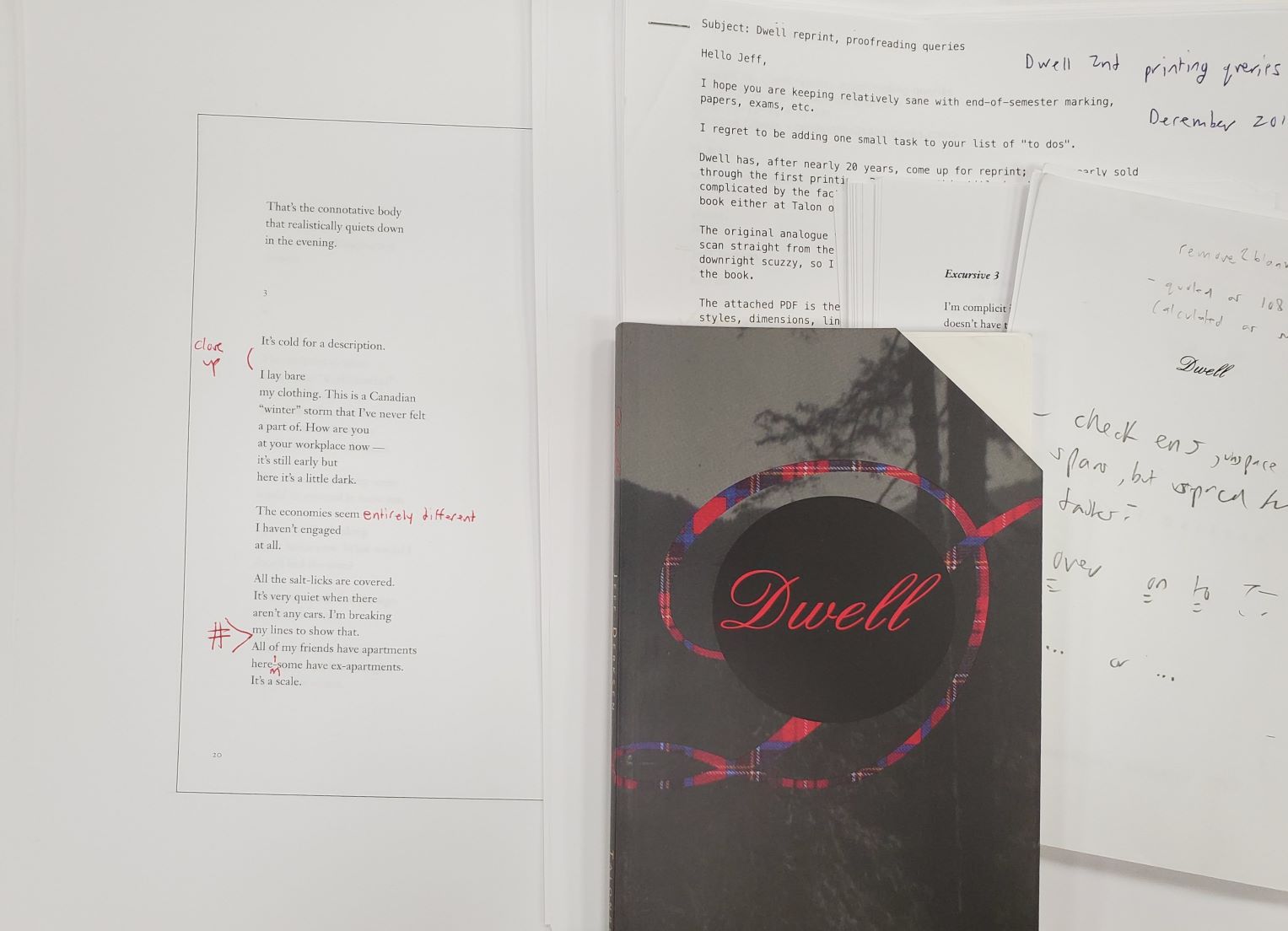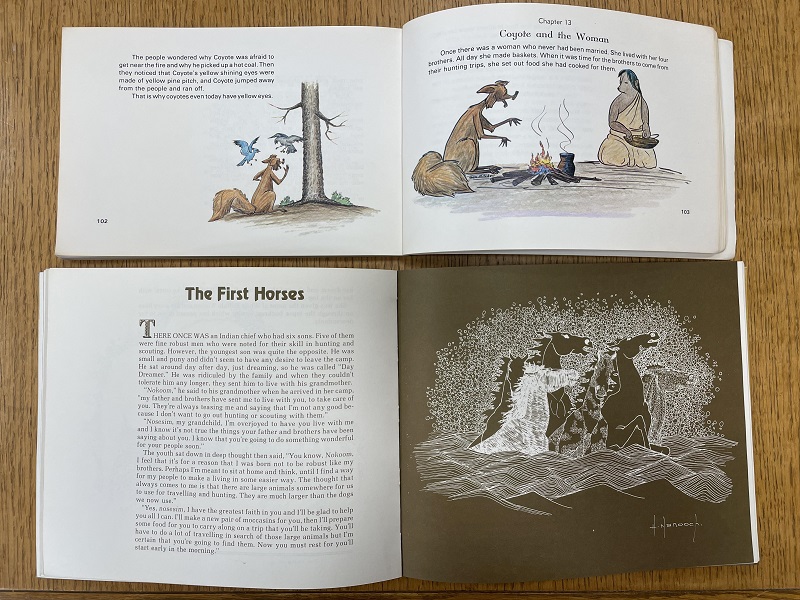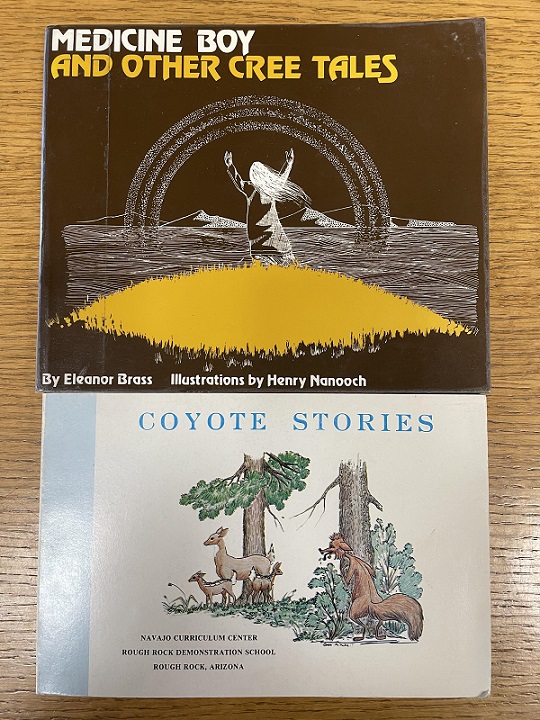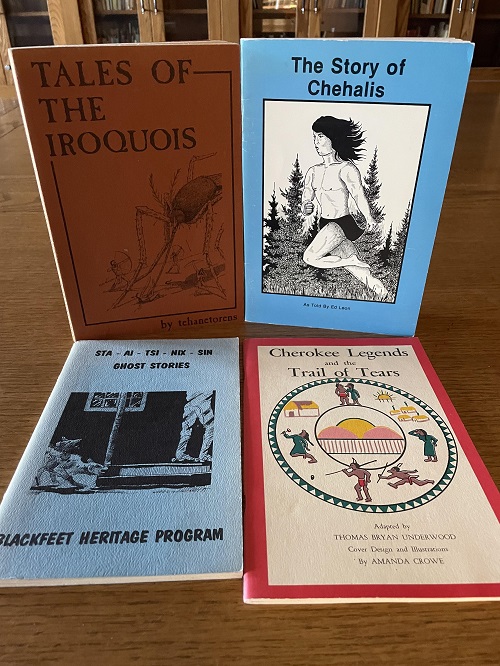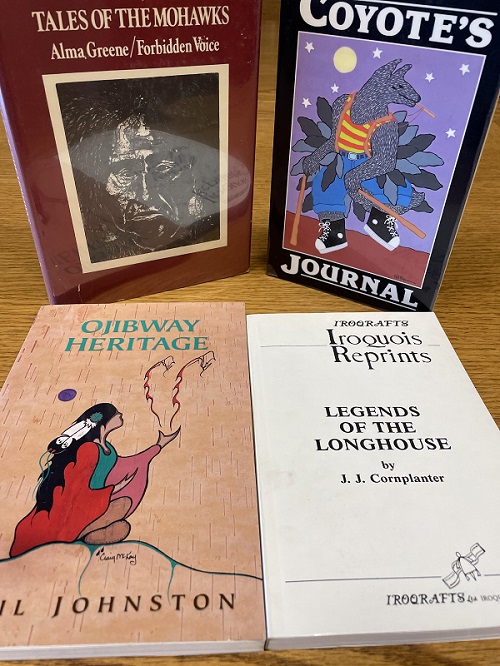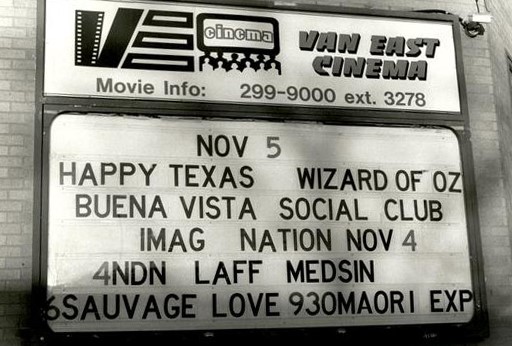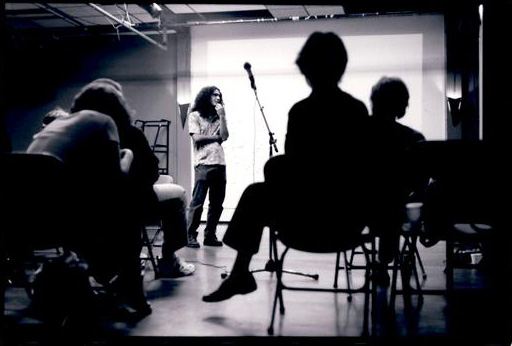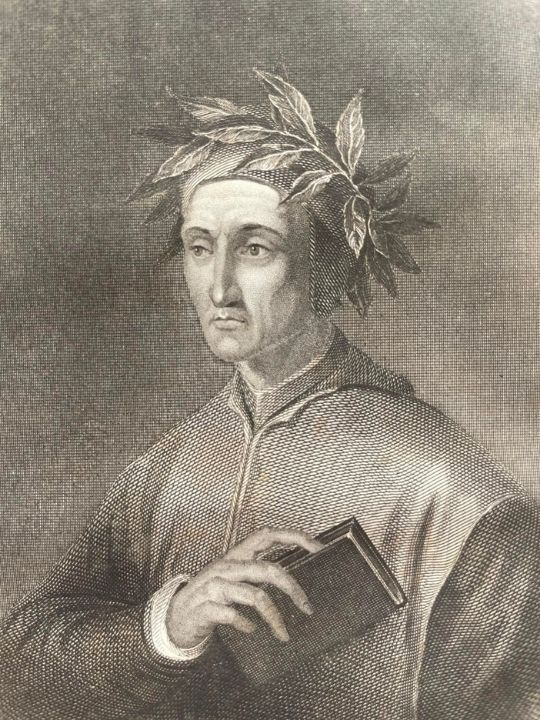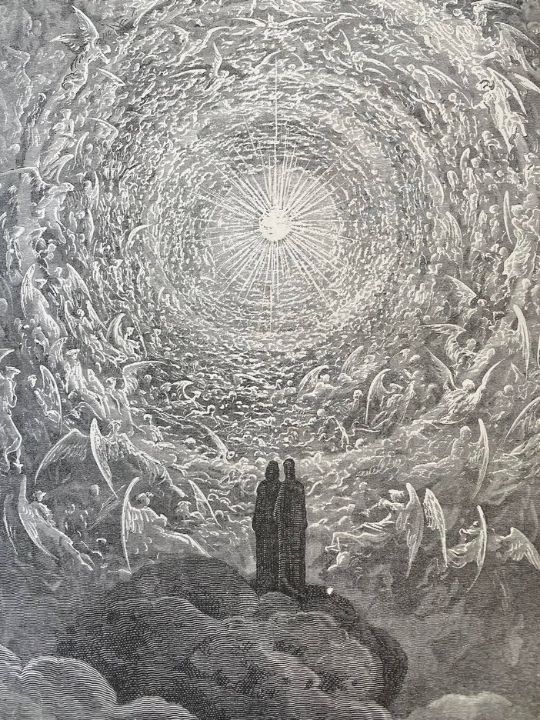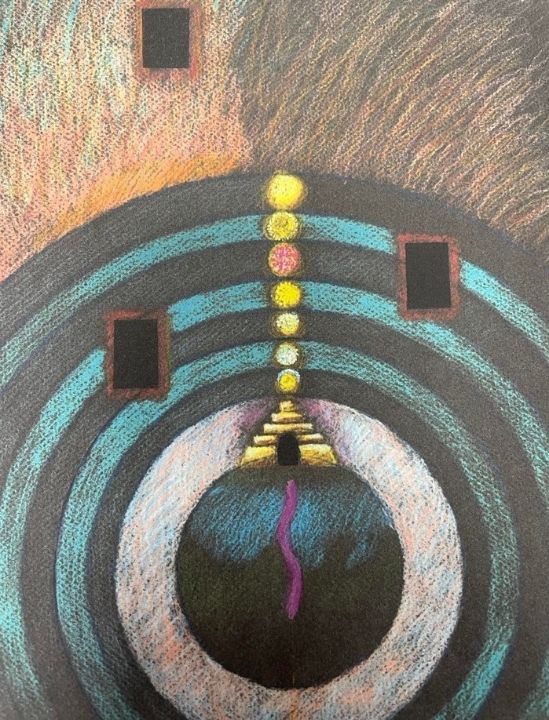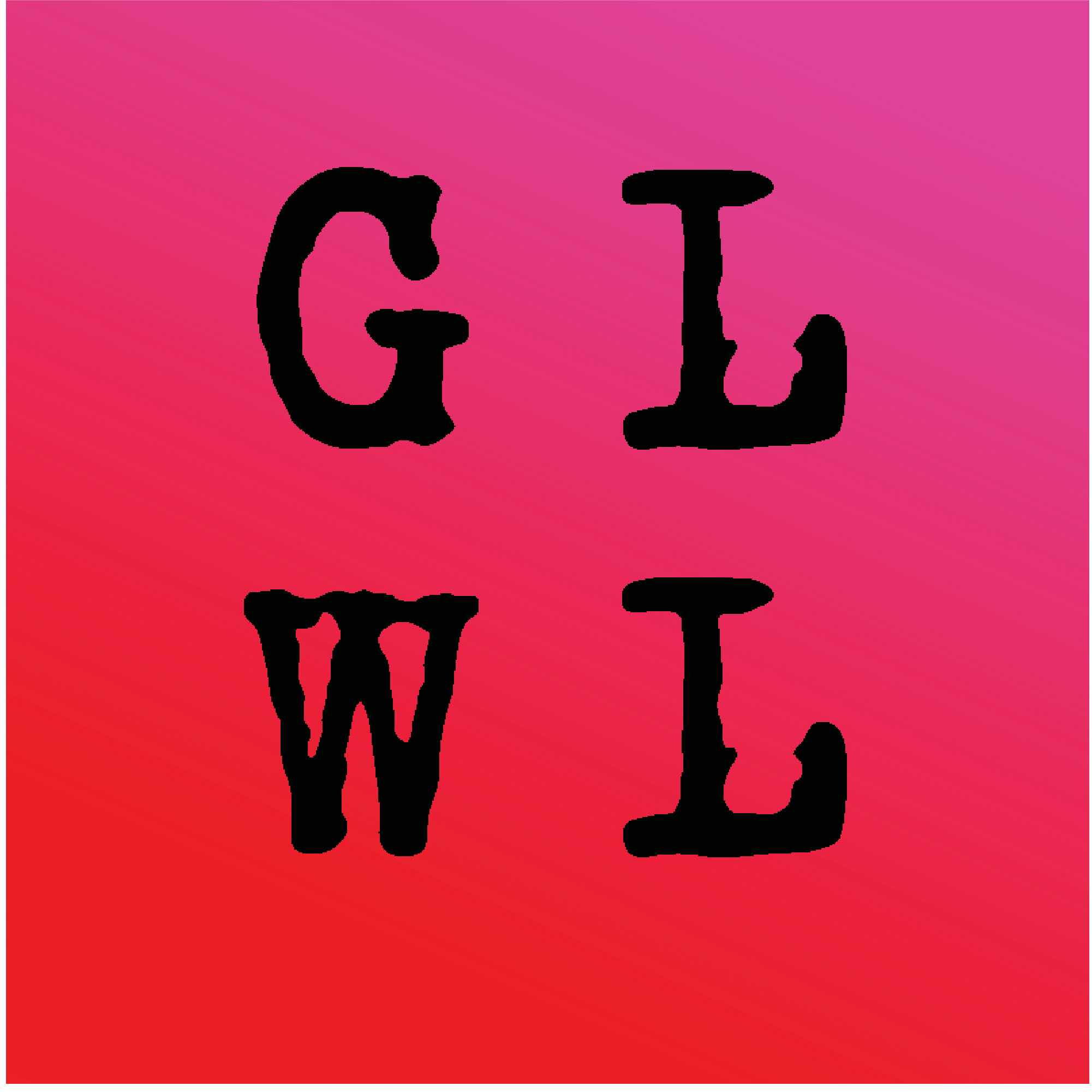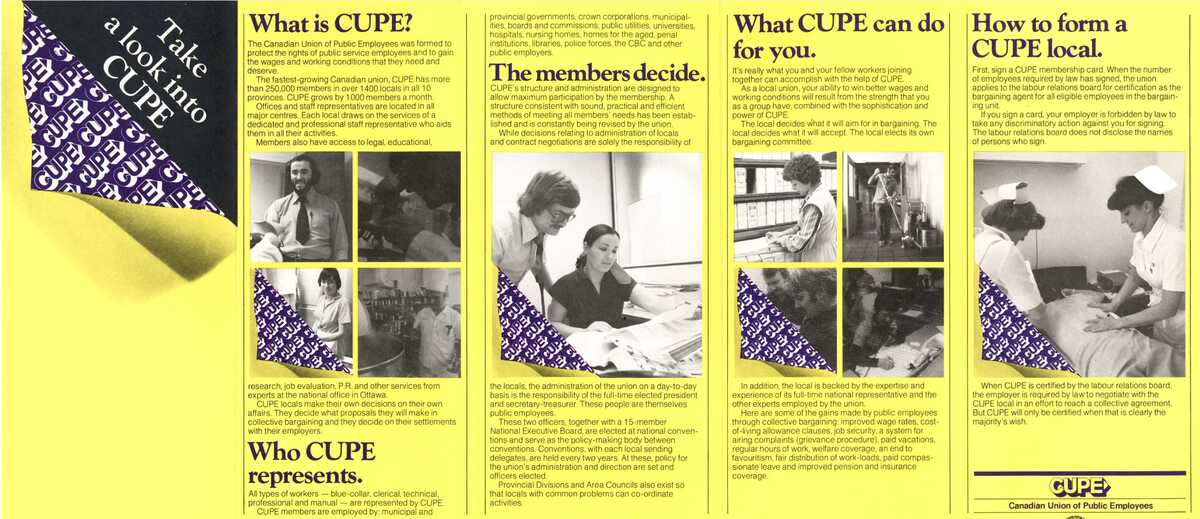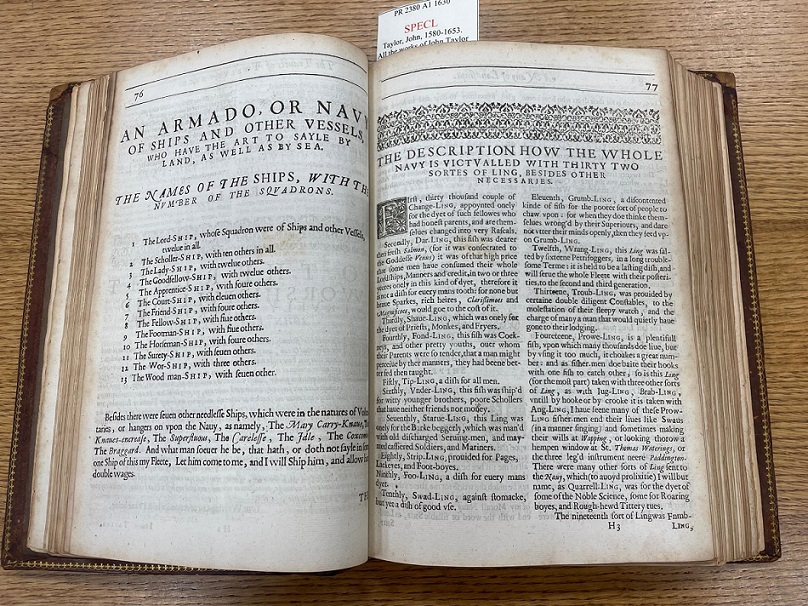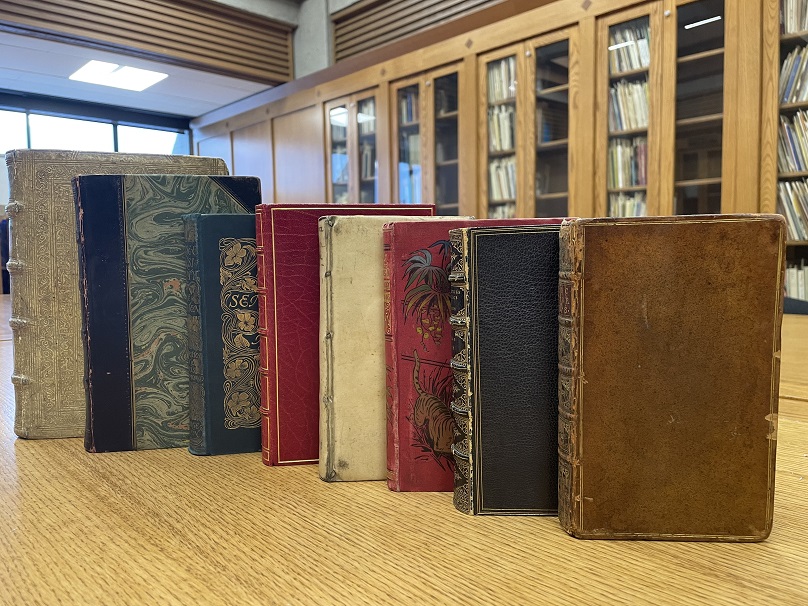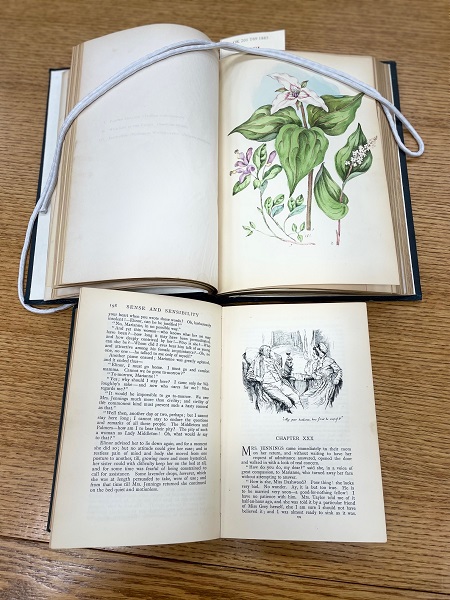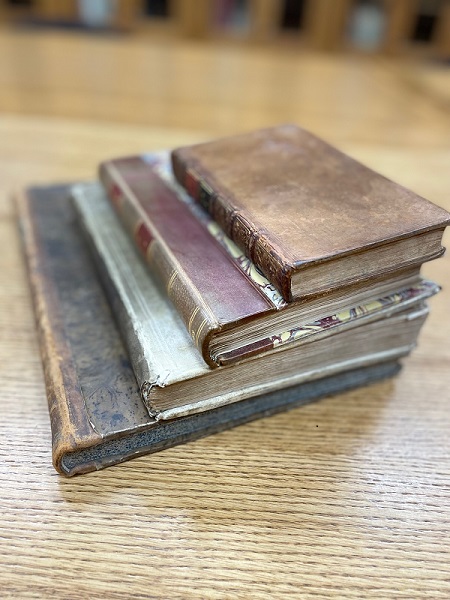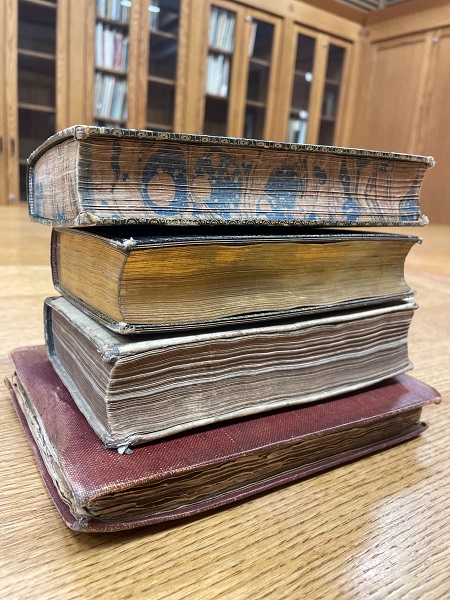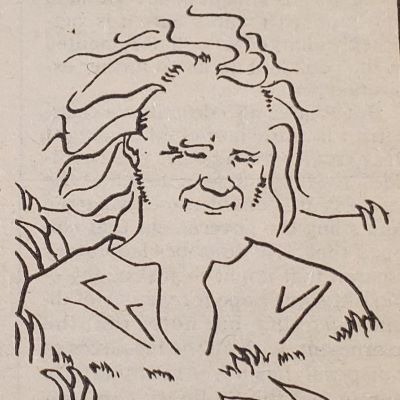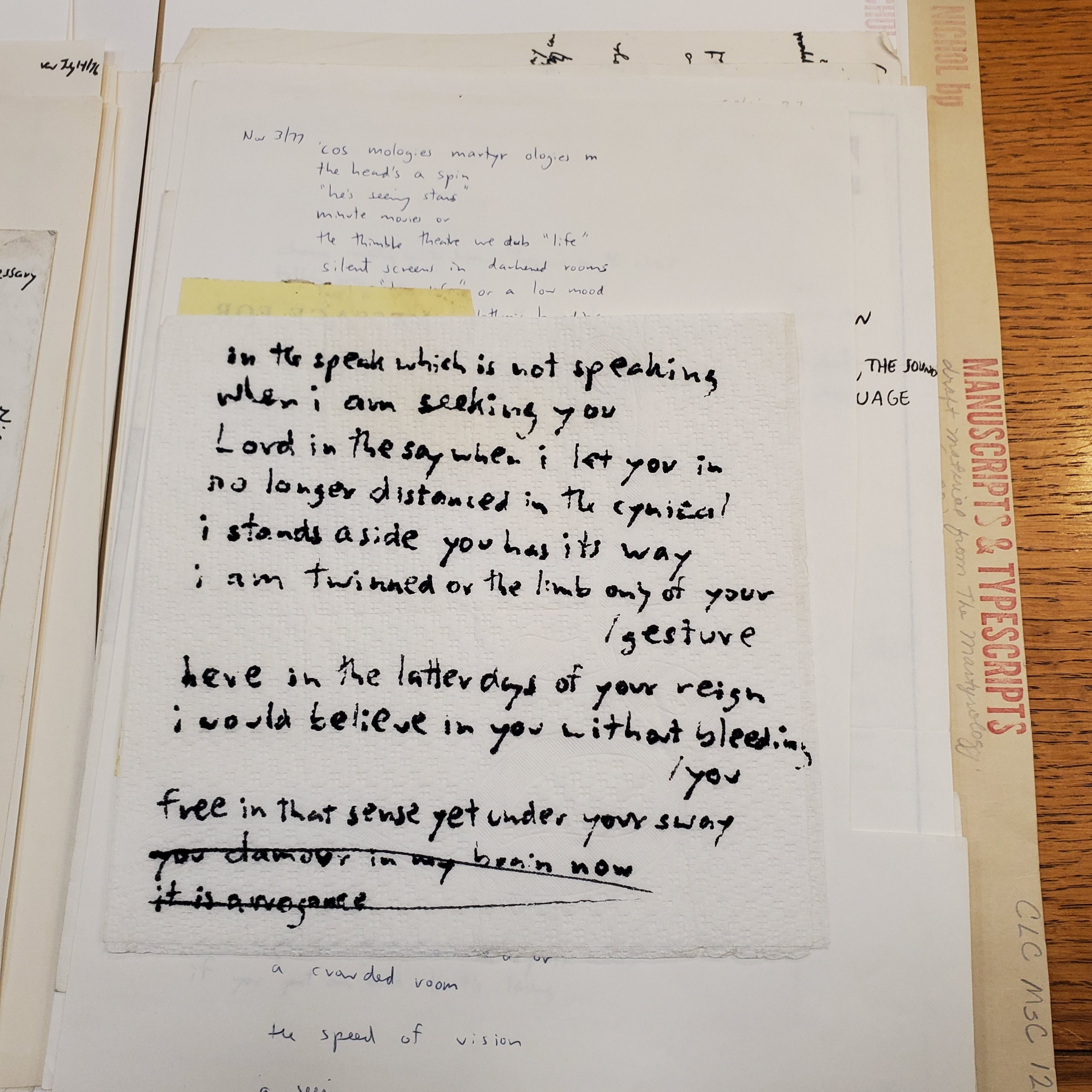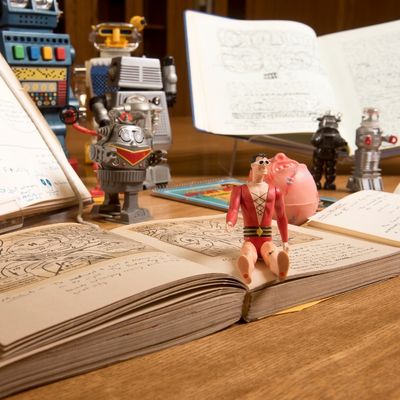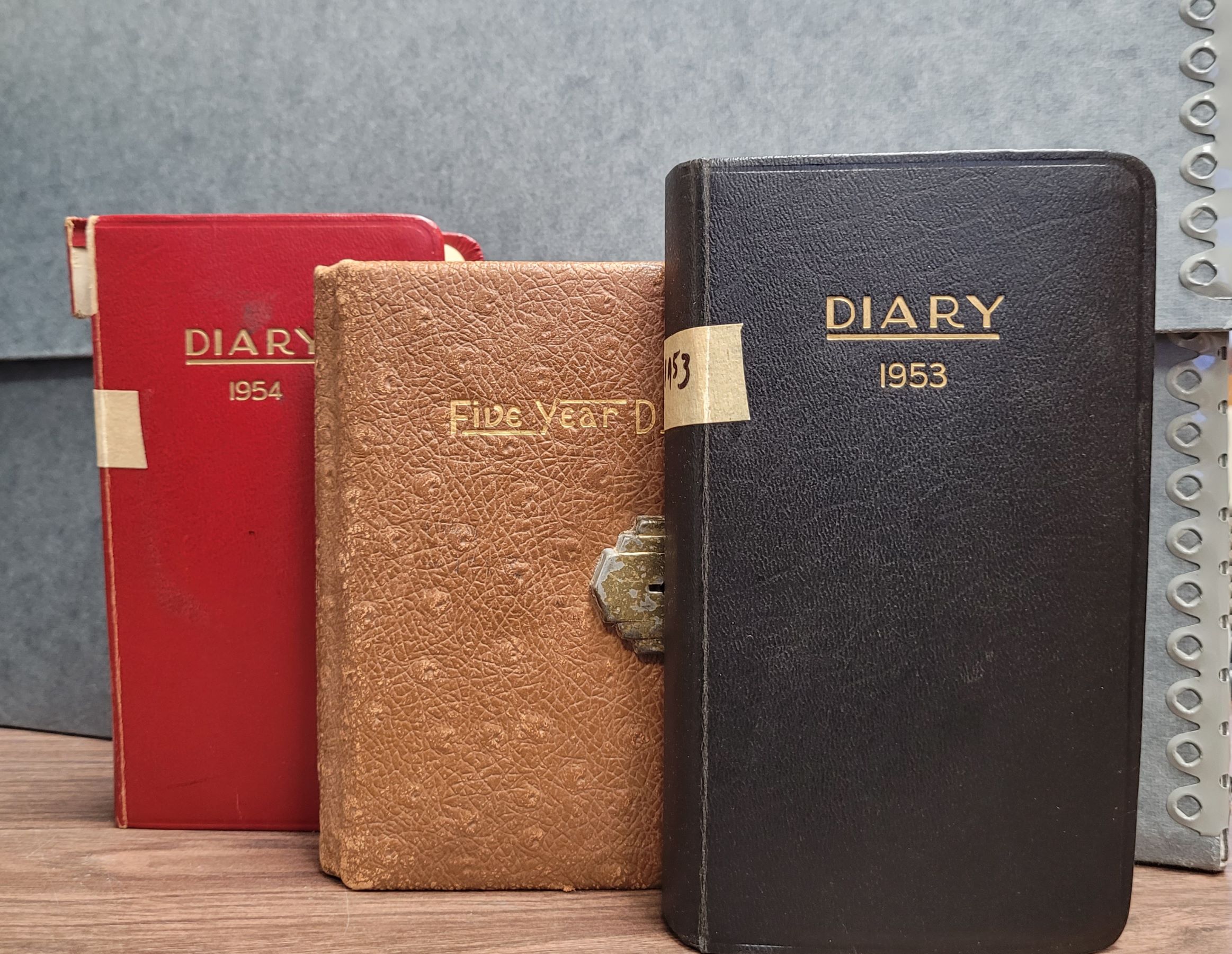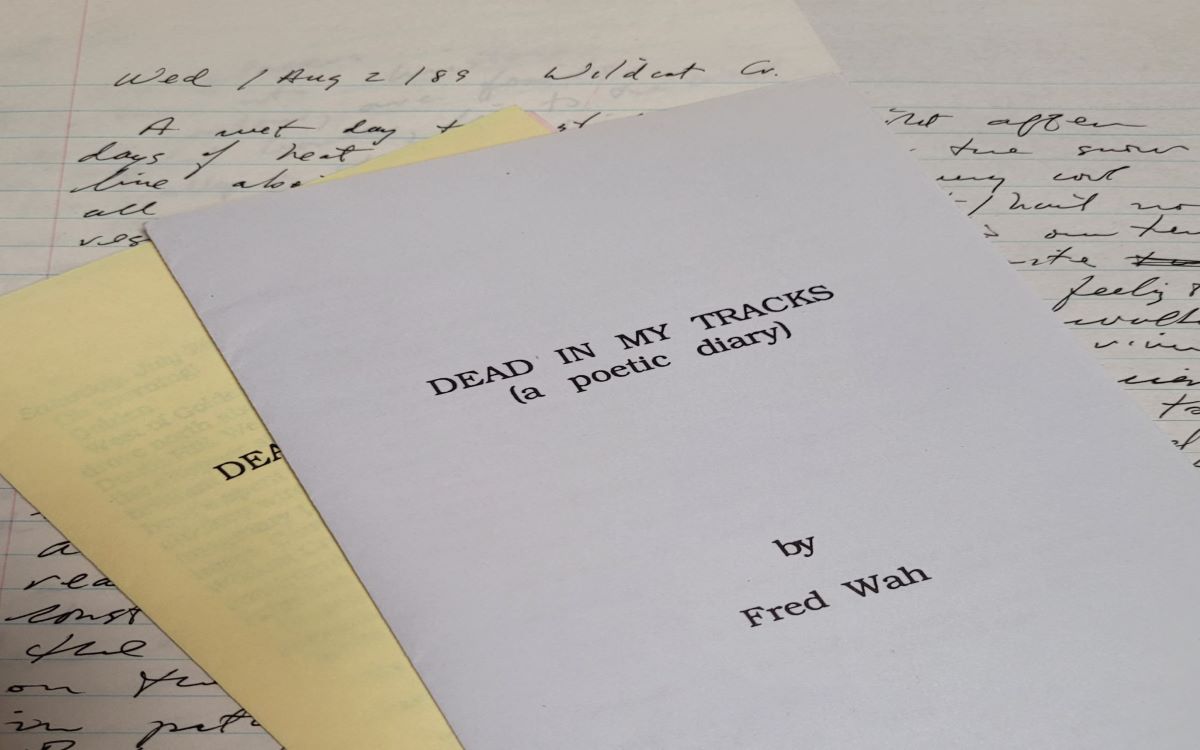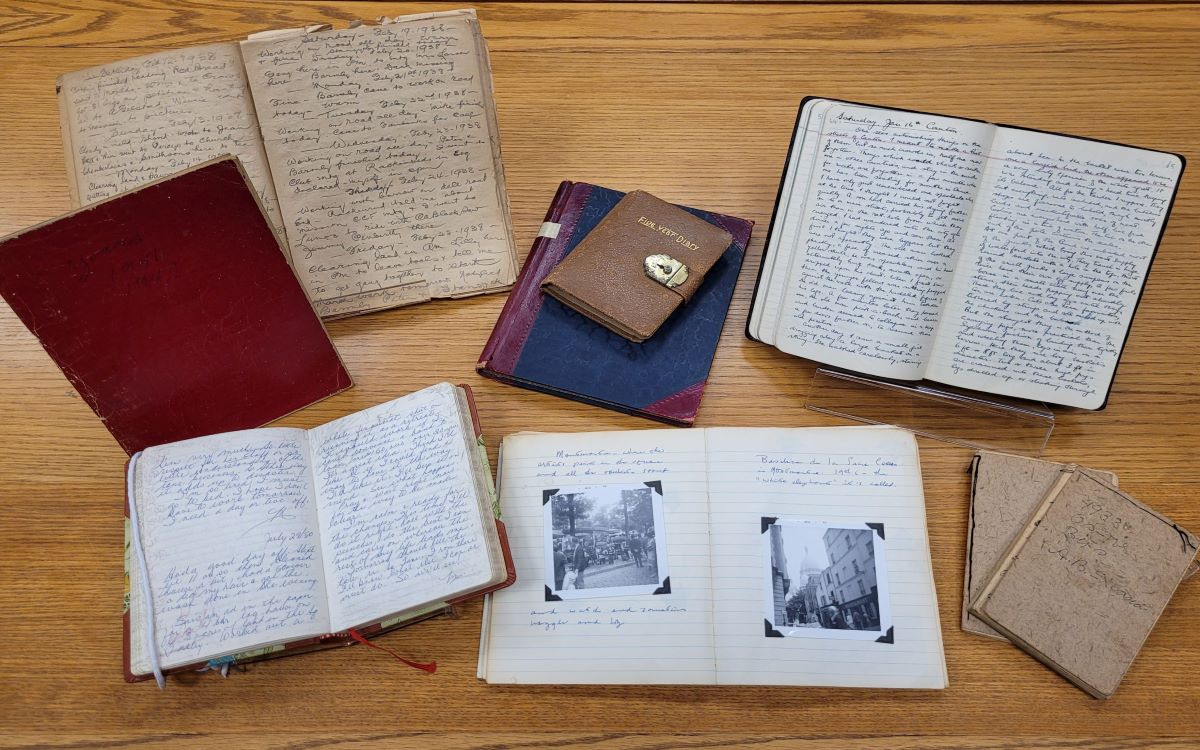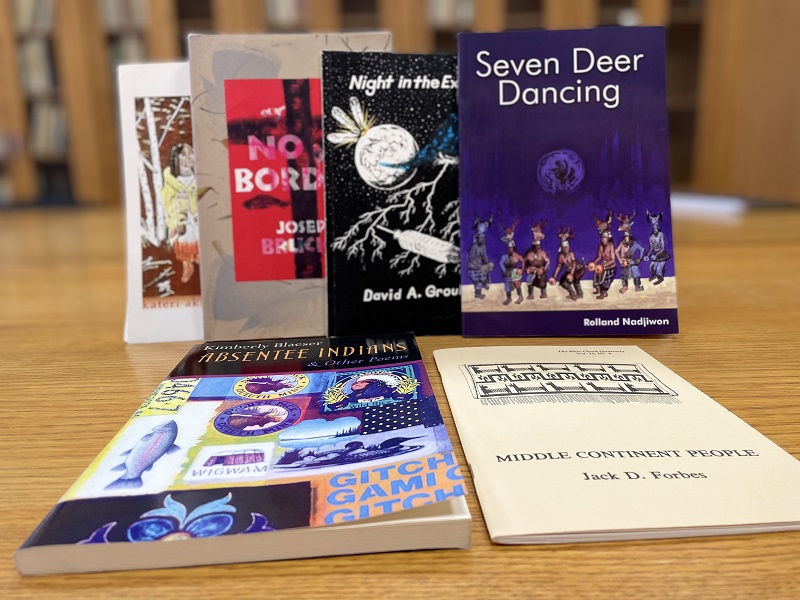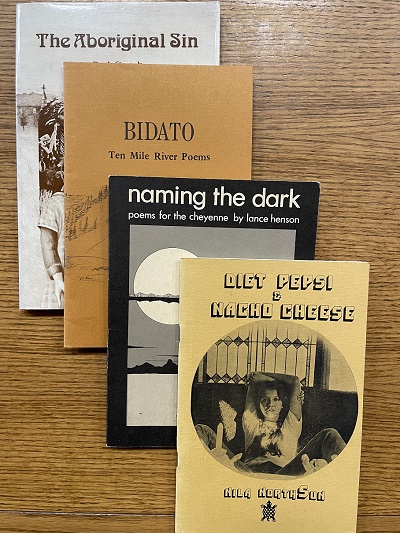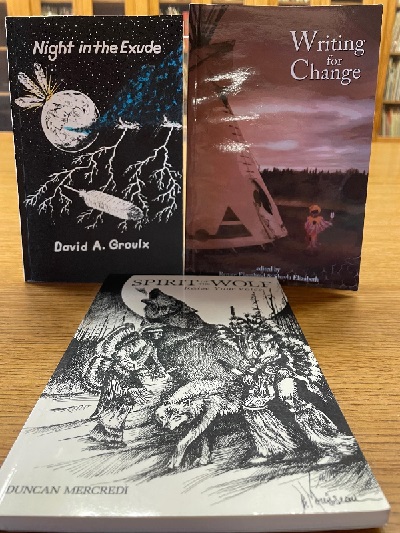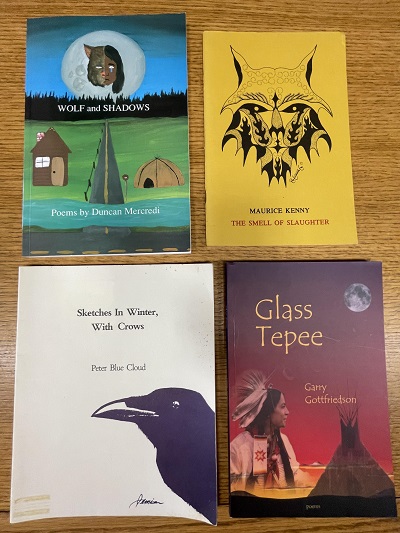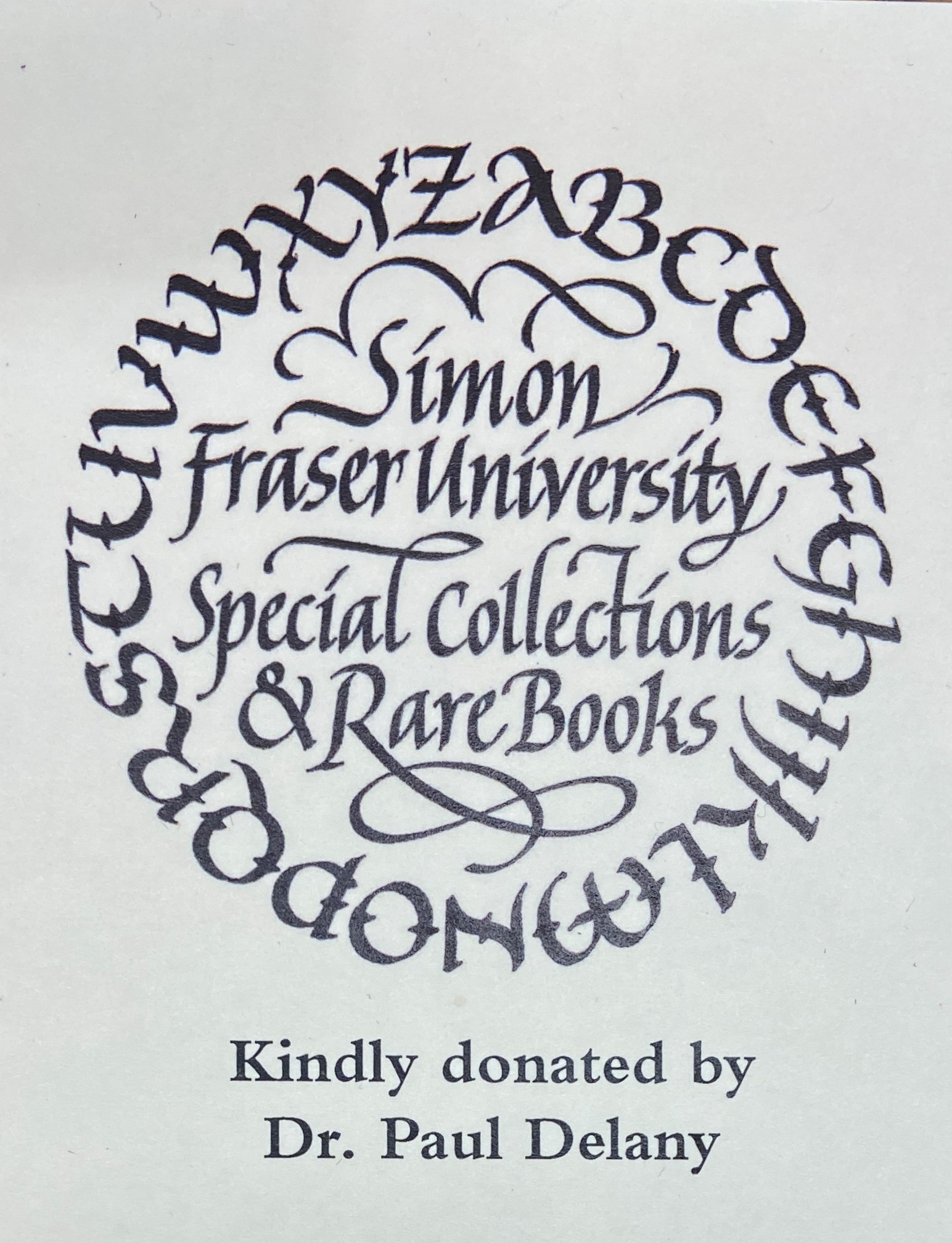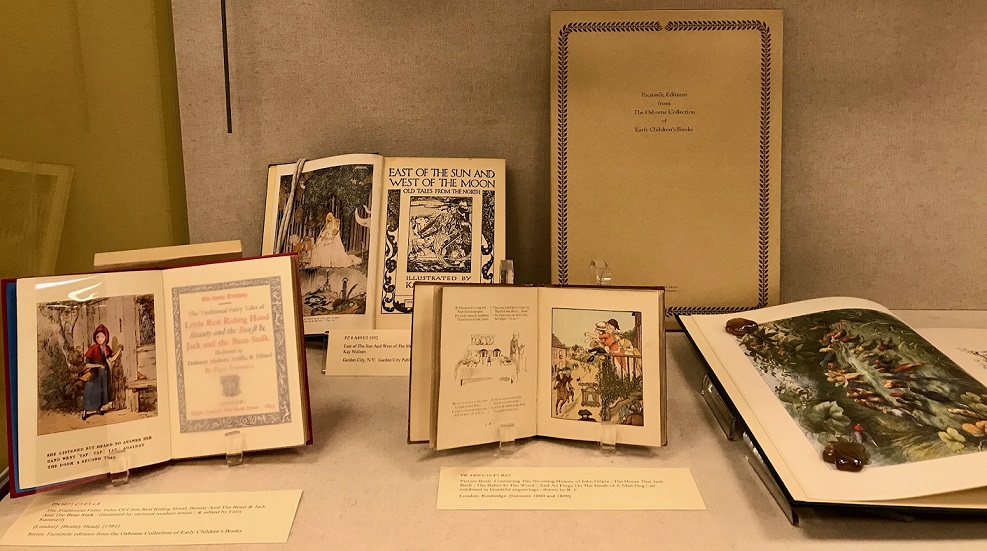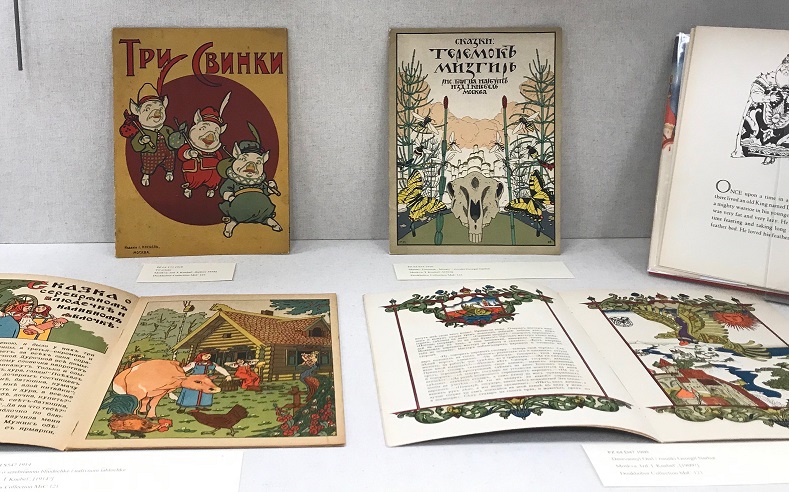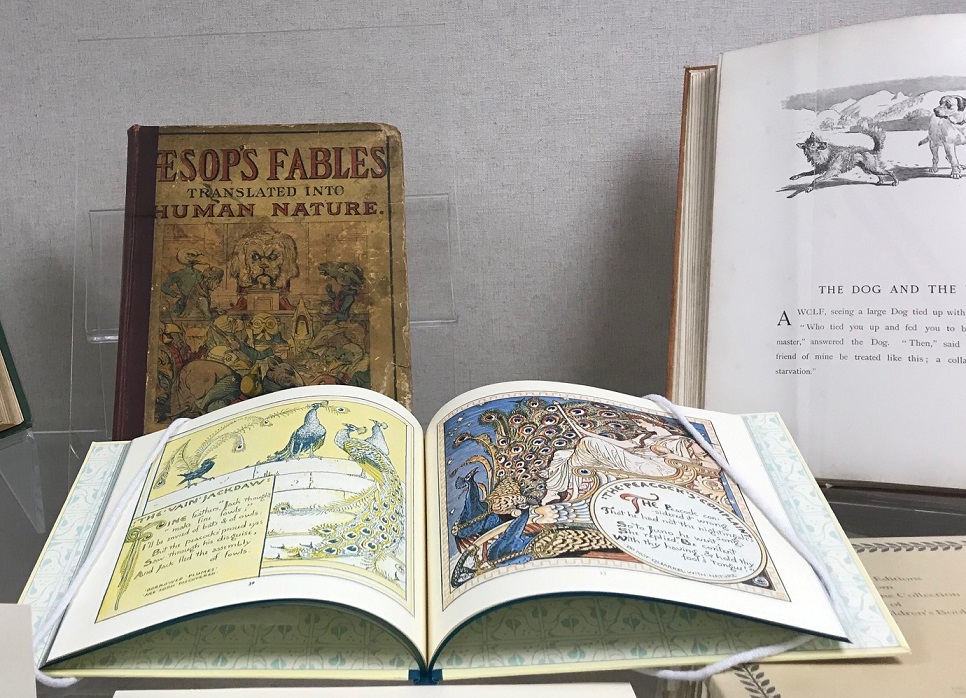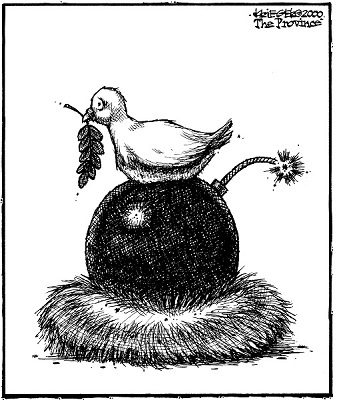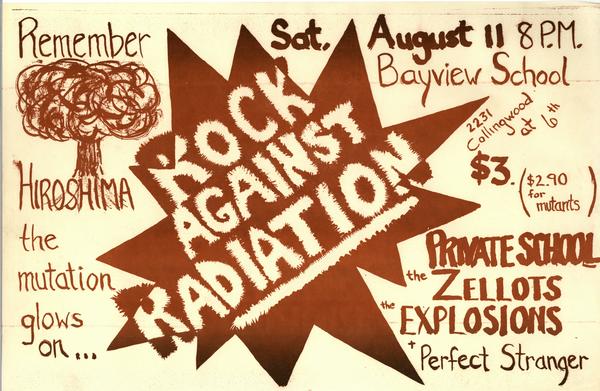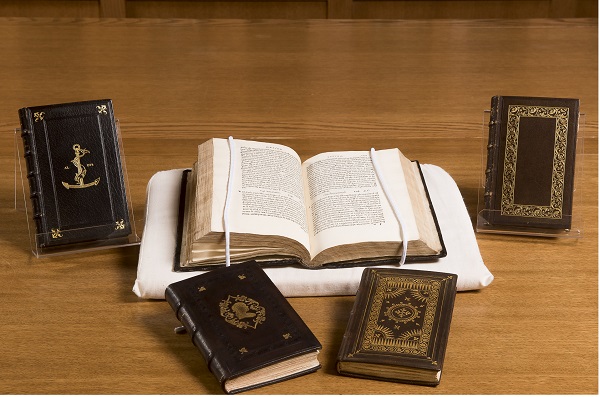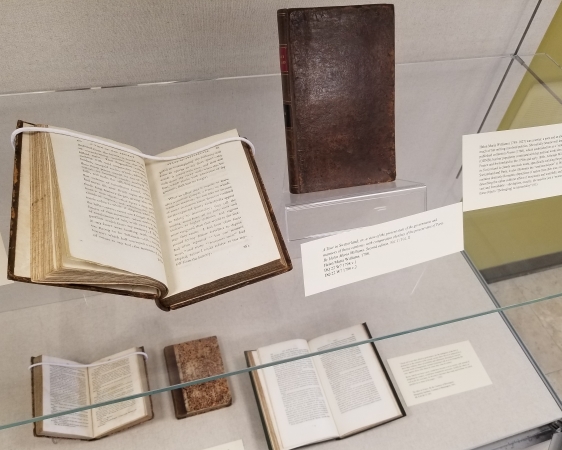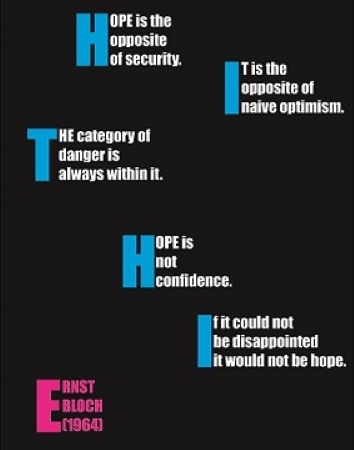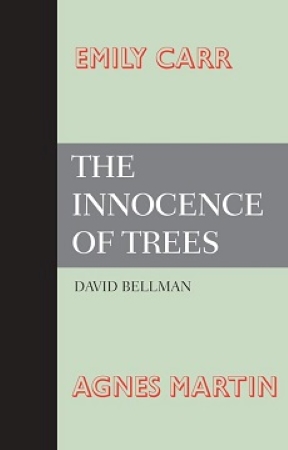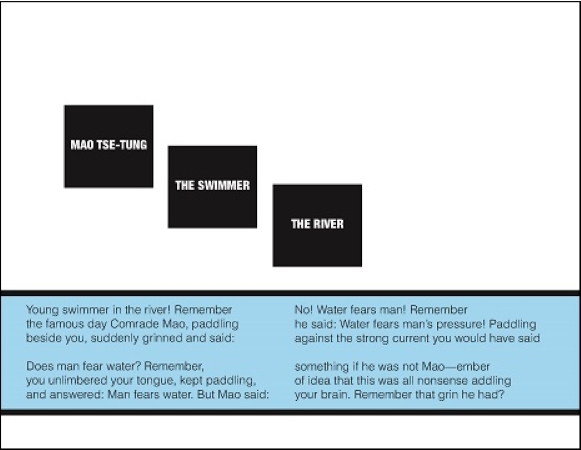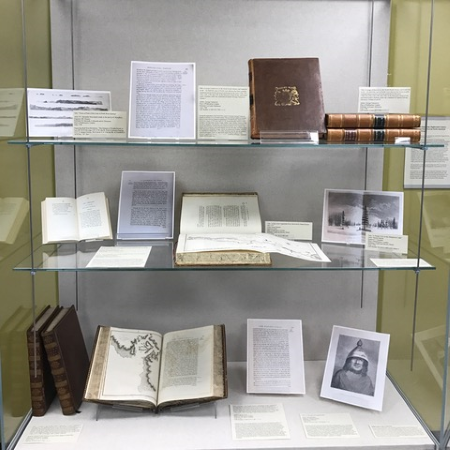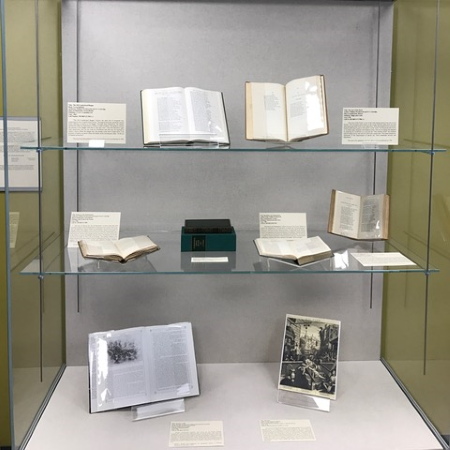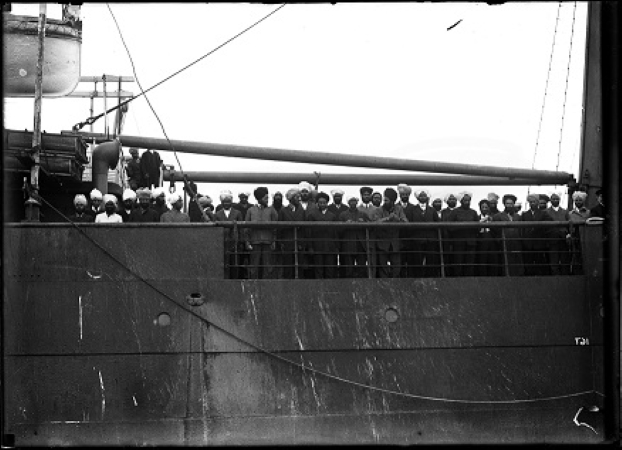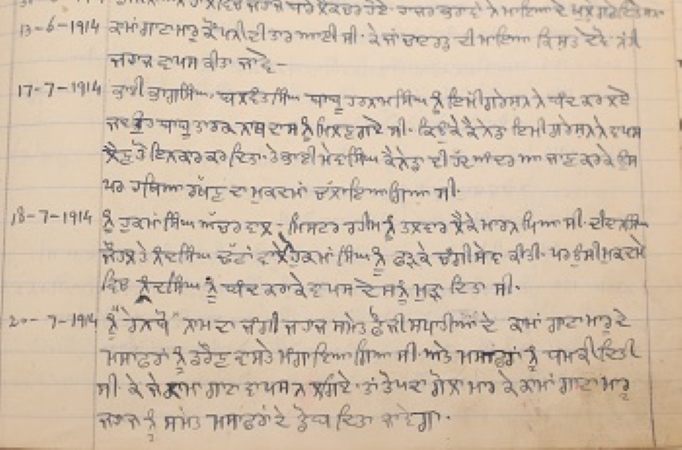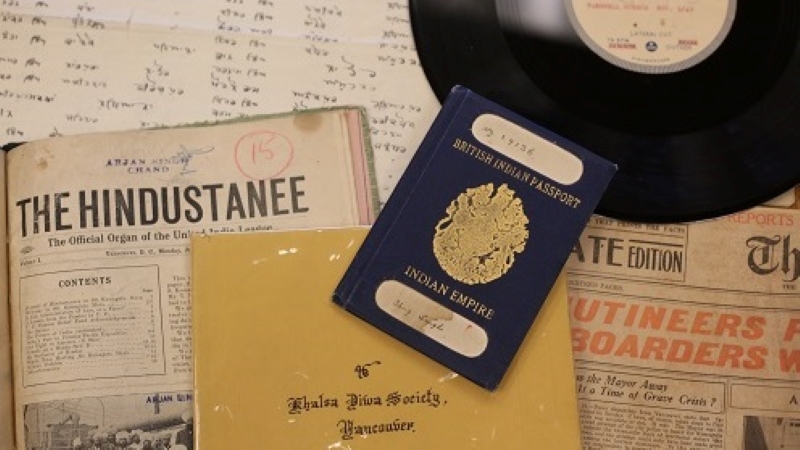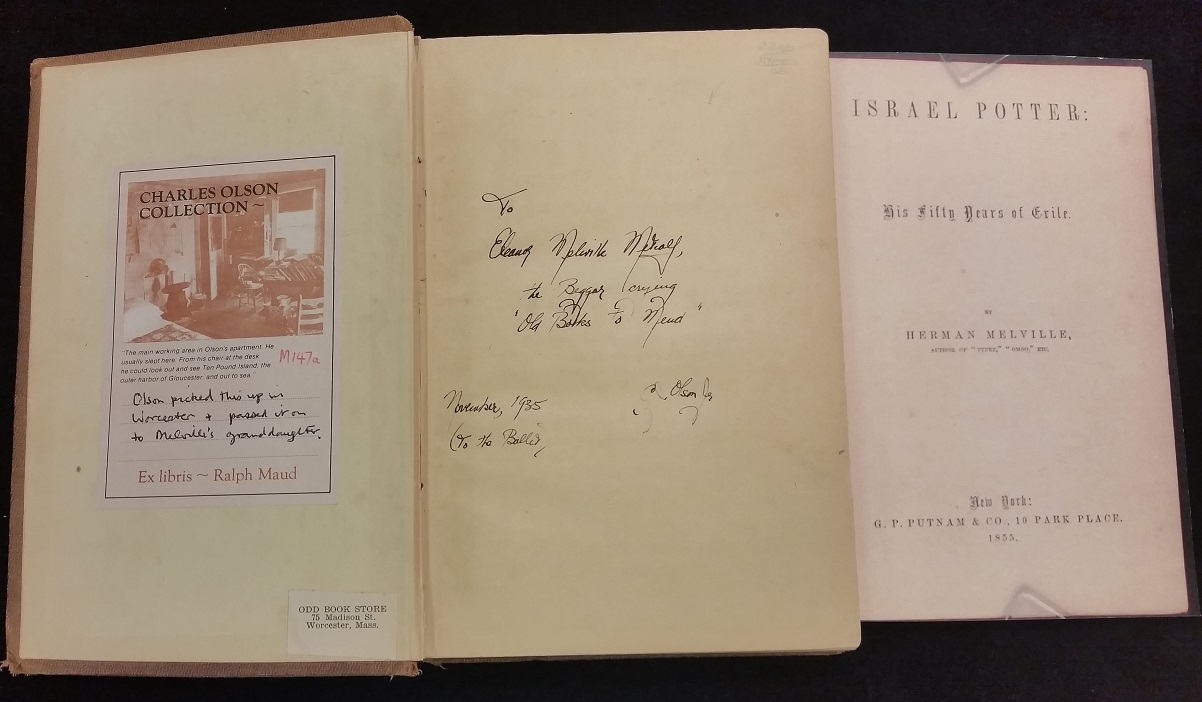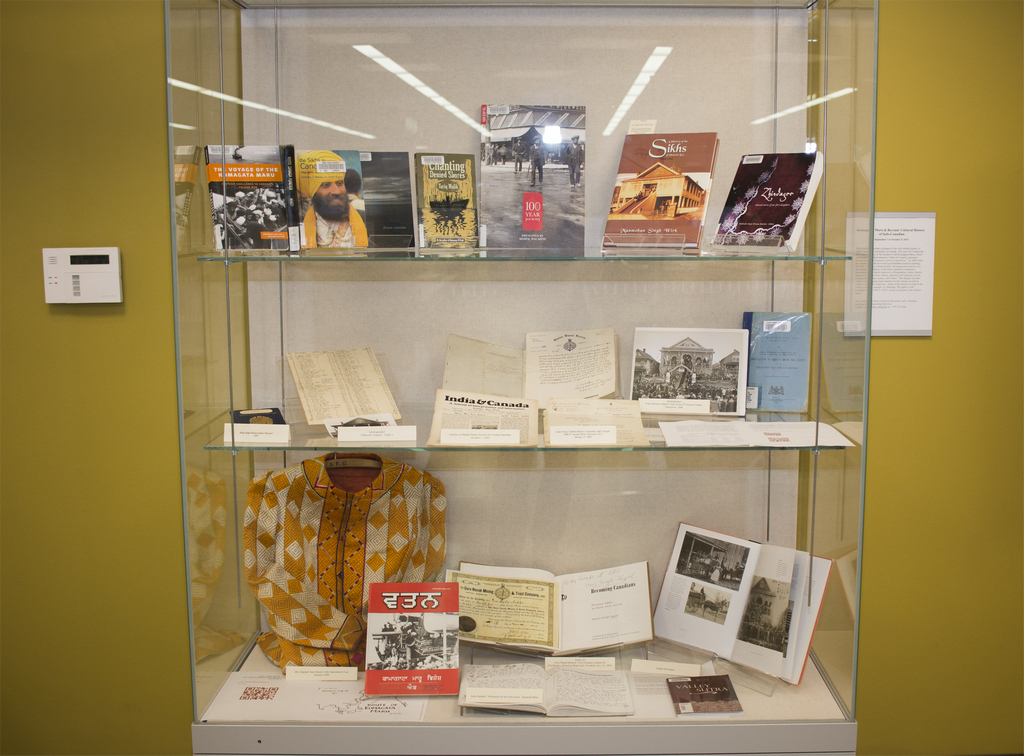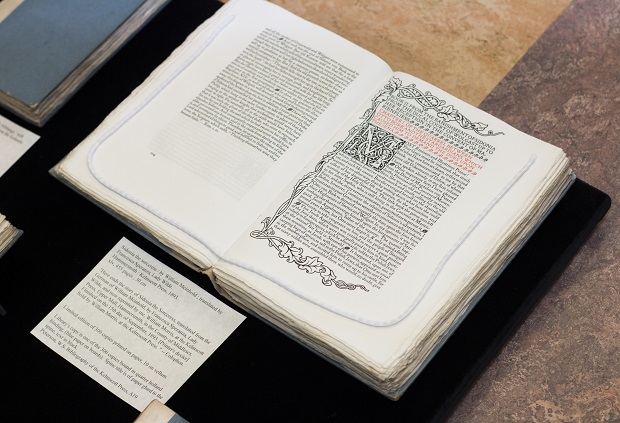On this page
- 2025 exhibits: Foodies and Flavours
- 2024 exhibits: Archival Oddities; Lisa Robertson's Vancouver; WORD-IN-PROGRESS; Destroying Tradition; Protest!; Zine Scene!
- 2023 exhibits: Ex Libris Robin Blaser; Phyllis Webb Memorial Reading; Anfield Collection; From Draft to Book; Indigenous Storytelling; IMAGeNation
- 2022 exhibits: Depicting Dante; Writing Canadian Women; CUPE BC; Bindings and Beyond; bpNichol; Diaries; Indigenous Poetry
- 2021 exhibits: Early writing materials and technologies; Henry James; Wood engravings
- 2020 exhibits: BC fine and private presses; Fairy tales and fables
- 2019 exhibits: Rocking against Radiation; Venetian Renaissance illustration
- 2018 exhibits: Women of Wordsworth
- 2017 exhibits: "Allied Arts' Affirmative;" Modern first editions; Canada 150; Student-curated exhibits; Alcuin Society awards
- 2016 exhibits: Komagata Maru documents; Wordsworth Country; Charles Olson
- 2015 exhibits: Thank you to donors; Robin Blaser; Komagata Maru; William Morris
2025 exhibits: Foodies and Flavours
Foodies and Flavours: Cookbooks as Historical Insight (January to April 2025)
What's on display
The exhibit includes:
- Recipes in personal archives: Doukhobor Collection, Ethel and Allan Grant collection, Shani Mootoo fonds
- Eighteenth and nineteenth century recipes and flavours: The Receipt Book of Elizabeth Raper, More Lovely Food
- Beyond cooking: domestic manuals and more – cooking methods and tips, food storage, preservation and homemaking: The American Woman's Home
- Canadian historical flavours:
- Vintage recipes: Vincent Galleries Book of Cookery, Cooking For One, Canadian Favourites
- From local producers to a plate: The Cannery Book, Rogers Recipes
- Canadian fusion and themed recipes: Doukhobors, Chinese and Sherlock Holmes cookbooks
- Modern cooking - Alcuin Society award-winning cookbooks: Modern Lunch, Earth To Table Every Day, The Dirty Apron Cookbook
More images from the display
2024 exhibits: Archival Oddities; Lisa Robertson's Vancouver; WORD-IN-PROGRESS; Destroying Tradition; Protest!; Zine Scene!
Archival Oddities: Discovering the unexpected in Special Collections and Rare Books (January to April 2024)
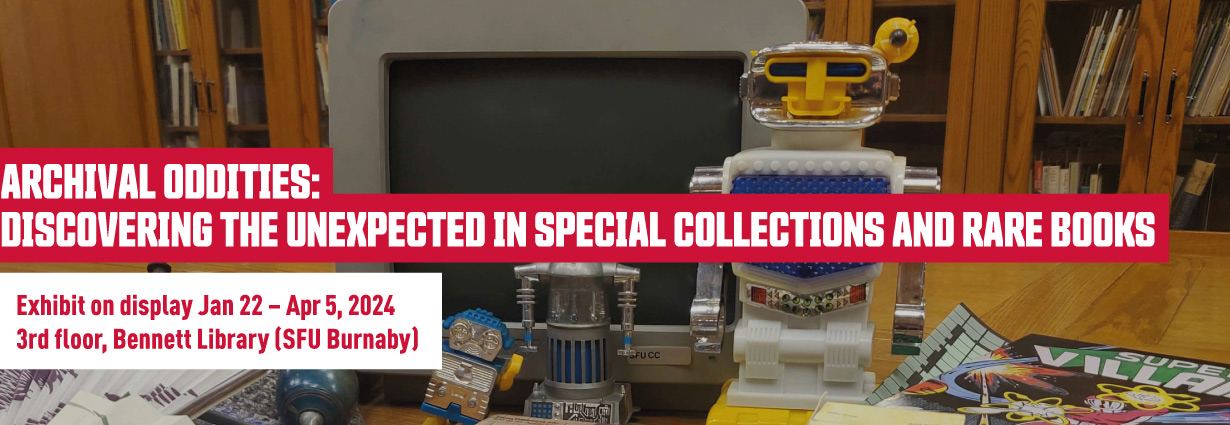
About the exhibit: What's in an archive?
What's on display?
Visit the Special Collections exhibit, Lisa Robertson's Vancouver (January to April 2024)
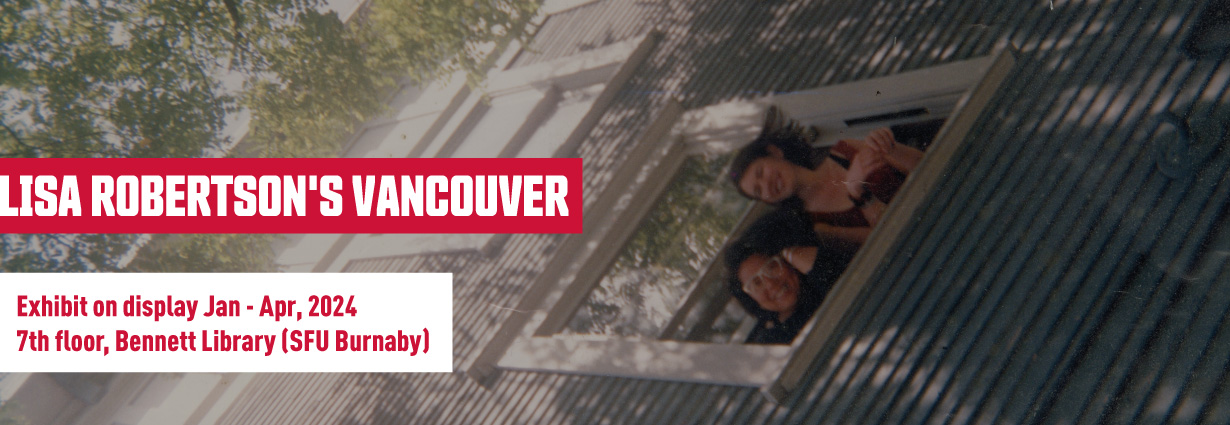
What's on display?
- rare books by Lisa Robertson
- ephemera created and collected by Robertson
- collaborations with Vancouver artists, including exhibition catalogues, fleeting publications, and more
- early little magazines and zines
About the curator
Katie Naughton is a poet and doctoral candidate in poetics in the English department at the University at Buffalo (SUNY). Her dissertation research is on the theorization of self-transparency and self-opacity in experimental poetry by women, and includes chapters on Lisa Robertson, Bernadette Mayer, and Mei-Mei Berssenbrugge. Archival research in support of the dissertation has been supported by grants from the University at Buffalo Graduate Student Association and the University of California – San Diego library, and Yale University’s Beinecke Library. Katie was the recipient of a Fulbright Canada 2022-2023 graduate student research fellowship at Simon Fraser University in Burnaby, BC. She is also the author of two poetry chapbooks and a poetry collection, The Real Ethereal, forthcoming from Delete Press in 2024; the founding editor of Etcetera, a journal of poetry and poetics; an editor at Essay Press; and an editor and project manager at the HOW(ever) and How2 Digital Archive Project.
Check out WORD-IN-PROGRESS, a Special Collections exhibit (May to August 2024)
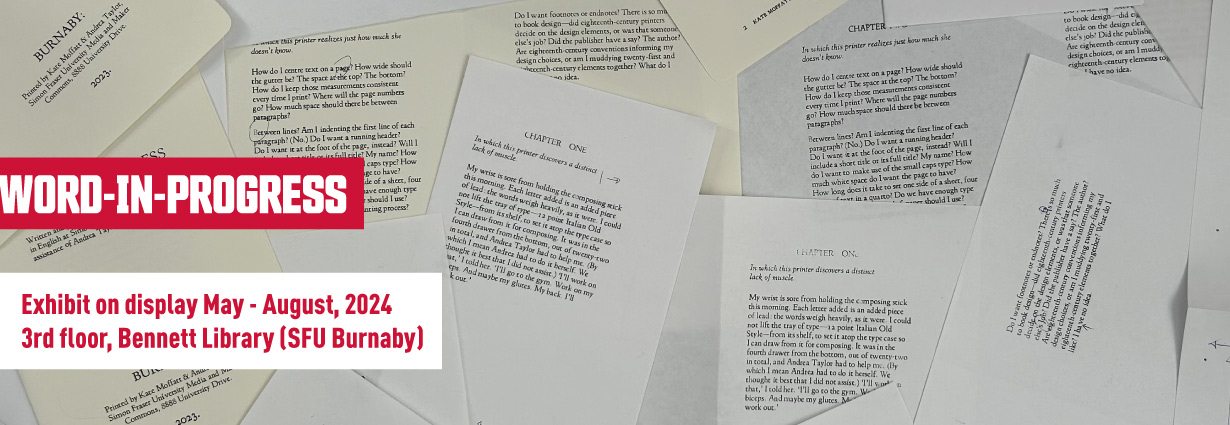
About the curator
Kate Moffatt is a PhD student in the Department of English at Simon Fraser University. Her research focuses on women in the eighteenth-century book trades, digital humanities and feminist data, and archival (in)visibility. She is the Project Manager and Lead Editor of Firms on the Women’s Print History Project.
Curator's acknowledgements
WORD-IN-PROGRESS (book) and WORD-IN-PROGRESS (exhibit) were created as part of a Special Collections and Rare Books Directed Study in Fall 2023. Huge thanks to Andrea Taylor, artist and printer, who oversaw my labour with the press and worked extensively with me on this project throughout the semester, the supervisory efforts and labour of Dr. Michelle Levy, and the enthusiastic support of Andréa Tarnawsky and Alexandra Wieland in Special Collections and Rare Books.
Visit Destroying Tradition, an exhibit at Belzberg Library (May to August 2024)

About the curator
Bran Eveland Cron is the Project Archivist at Special Collections and Rare Books. They first came to SCRB as an SFU undergraduate student and ARL Digital and Inclusive Excellence Fellow, 2018-2019. It was during this fellowship that they encountered the Vancouver Punk Rock Collection for the first time, which kickstarted their appreciation of worldwide punk rock music and activism.
Bran would like to thank Andréa Tarnawsky for their guidance, expertise, and unwavering patience through the process of making this exhibit possible.
Visit Protest! A Special Collections exhibit (September to December 2024)
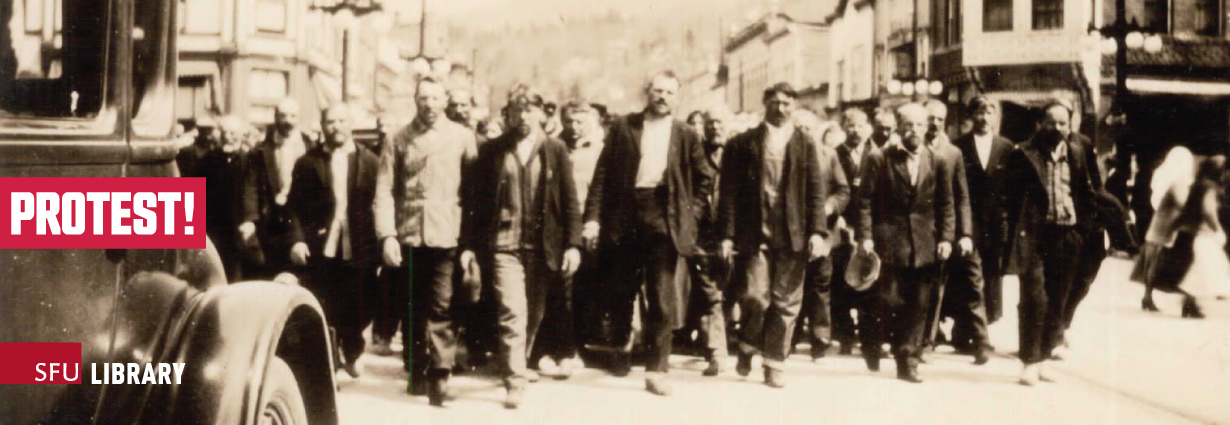
About the exhibit: Protest!
Protest is often defined as a public expression of objection, disapproval, or dissent towards an idea or action. It can also be framed in a positive way as an expression of support for a group, objective, or idea.
The exhibition on Protest! explores the diversity and creativity with which people in British Columbia have made and continue to make their voices heard. It features images of traditional protests, demonstrations, and rallies. More non-traditional forms of protest include graffiti or street art, zines, and a poetry writing campaign for peace.
International protest movements and forms of protest, such as the Occupy movement or peace walks, show up in a localized form in our university, city, and province. Other protest movements are specific to our communities and grow out of local concerns in our neighbourhoods, municipalities, and provinces.
From struggles to define religious freedoms, to issues related to peace, the environment, education, solidarity, and equity in our society, explore 100 years of protests in British Columbia.
What's on display
Learn more
See the Activism Research Guide for information about these and additional materials held in Special Collections and Rare Books
Zine Scene! A History of Zines at Special Collections (September 2024 to April 2025)
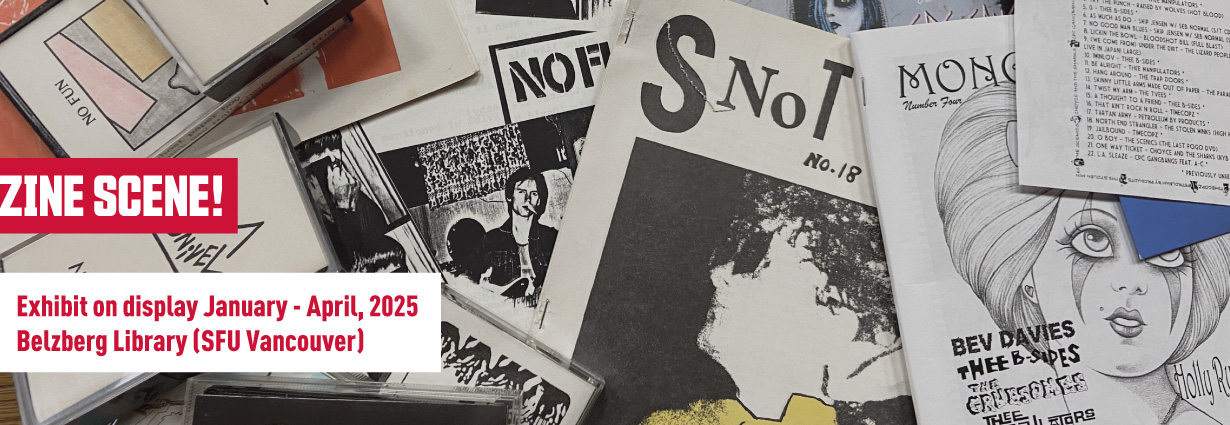
What's on display?
- Chapbooks, from 19th century miniature books (ca. 1840) to contemporary poetry chapbooks like Avant Canada: More Useful Knoweldge (2014)
- Little magazines from the 1960s to 1980s, including Ganglia, Iron, grOnk, and talon
- Punk fanzines like Snot Rag, photozines, and other punk music zines
- Contemporary chapbooks and zines, including perzines, compzines, political zines, and special collections zines
- Zines from behind the reference desk (zines made by SFU Library staff and librarians)
Learn more!
Discover more resources related to zines and alt-publishing curated by SFU Library in our Publishing Resources Guide.
Want to see more little magazines and alt-publishing in Special Collections? Check out our research guides on little mags and small press.
References
*Robinson, Lucy. "Zines and History: Zines as History." In Ripped, Torn, and Cut: Pop, Politics and Punk Fanzines, from 1976, edited by Subcultures Network, 39-54. Manchester: Manchester University Press, 2018.
2023 exhibits: Ex Libris Robin Blaser; Phyllis Webb Memorial Reading; Anfield Collection; From Draft to Book; Indigenous Storytelling; IMAGeNation
Peek into the personal library of renowned Canadian-American poet Robin Blaser (March to May 2023)
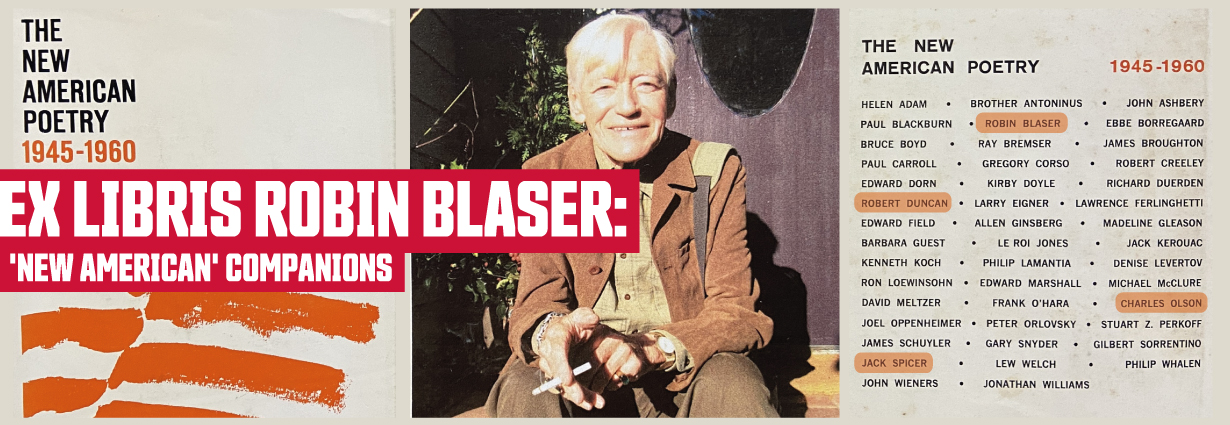
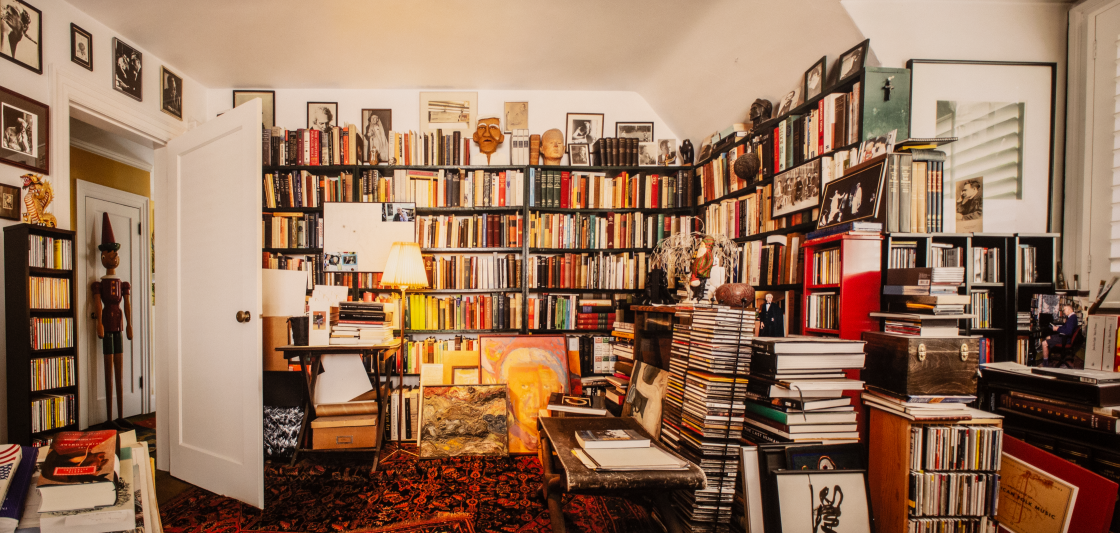
What's on display
The exhibit includes:
- Editions of The New American Poetry 1945-1960, edited by Donald M. Allen
- Books from the personal library of Robin Blaser
- Uncommon editions of books by Blaser, Spicer, Duncan & Olson. For comprehensive collections of their writings see:
- The Holy Forest by Robin Blaser
- My Vocabulary Did This to Me by Jack Spicer
- Collected Early Poems and Plays and Collected Later Poems and Plays by Robert Duncan
- Collected Poems of Charles Olson by Charles Olson
View the exhibit, Beyond the Vision Tree: Phyllis Webb in Conversation (April to August 2023)
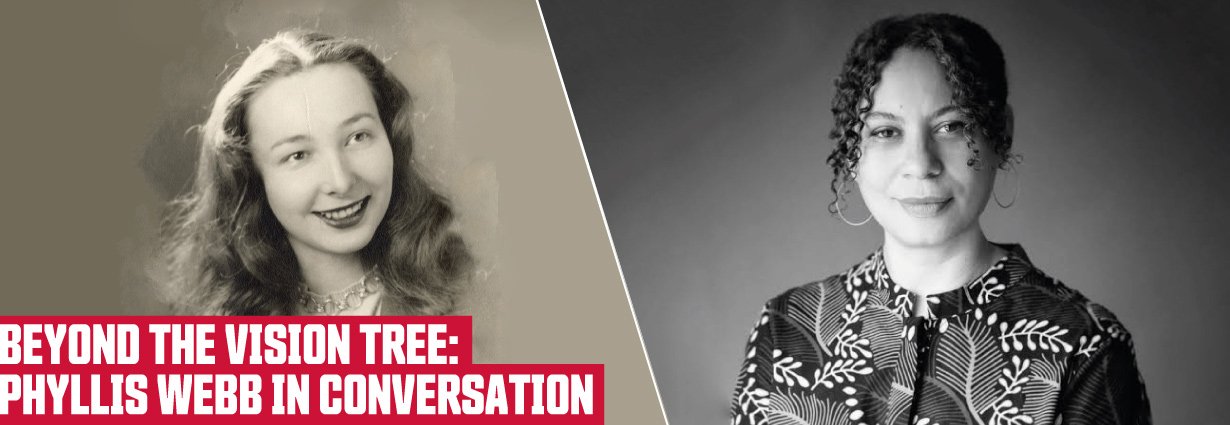
Such a legacy has inspired the Phyllis Webb Memorial Reading, which honours a Canadian poet with a cash award and a celebration of their work. This event will occur each April and will be organized and administered by the Poetry in Canada Society.
About the exhibit
Beyond the Vision Tree: Phyllis Webb in Conversation puts Webb's personal archival materials in conversation with the personal collection of Cecily Nicholson, the winner of the first annual Phyllis Webb Memorial Reading award.
Webb's work often centered around death, politics, and the power of passiveness. By taking a look at her letters, images, and legacy from her personal archive, both readers and writers can better understand what it meant to approach broadcasting and writing with a philosophical and meaningful lens, spanning from the late 1960’s up until her death in November 2021. This exhibit is curated by Bianca Weima, a Bachelor of Arts candidate in English and Publishing at Simon Fraser University.
What's on display?
Notable materials from Webb's archive that will be on display include:
- early and rare editions of Webb's works
- medals and other materials related to Webb's Order of Canada
- photographs of Webb throughout her life and career
- cassette tapes and other ephemera
As a complement to these materials, the exhibit will also feature some of Cecily Nicholson's personal archival materials, alongside published works from Otoniya J. Okot Bitek, Junie Désil, and Stephen Collis.
View Visual Voyages: Selections from the Anfield Collection (April to May 2023)
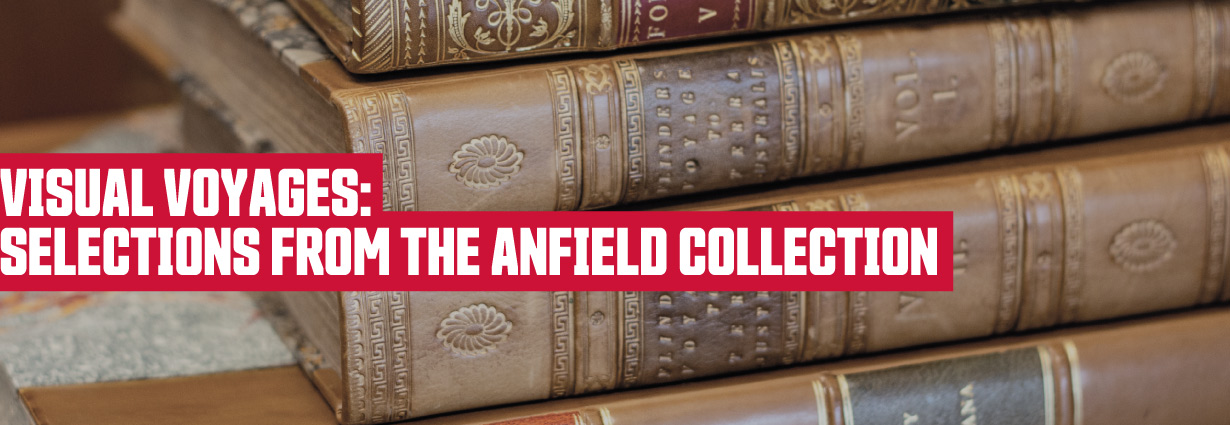
About the exhibit
SFU Library is delighted to showcase selections from this remarkable collection of 79 antiquarian books on the topic of voyages of European exploration in the Pacific and Arctic.
Inspired by a love for the sea and maritime history, SFU alumnus and donor Frank Anfield began acquiring these texts over 50 years ago. Primarily from the 18th and 19th centuries, the collection includes books by explorers such as James Cook, George Vancouver, Alexander Mackenzie, and Roald Amundsen.
In gifting the Anfield Collection to SFU Library, Anfield has enabled readers to engage with colonial perspectives in more nuanced ways, including by reading them alongside archeological records and Indigenous histories (oral and written).
What's on display?
Highlights of the collection include the first English language edition (1772) of the official French expedition led by navigator Louis de Bougainville. This expedition included botanist Jeanne Baré who became the first woman known to have circumnagivated the globe.
Another notable title is the first English language edition (1908) of Norwegian explorer Roald Amundsen’s 1903-1907 voyage, the first European expedition to successfully traverse the Northwest Passage.
These voyages included professional artists and scientists who were charged with documenting plants, animals, and weather patterns; charting maps; and recording the Indigenous peoples and cultures already inhabiting these places.
The items selected for display convey the rich and wide variety of illustrations, maps, and charts on offer in these texts.
Explore From Draft to Book : A Journey Through the Publishing Process (May to December 2023)
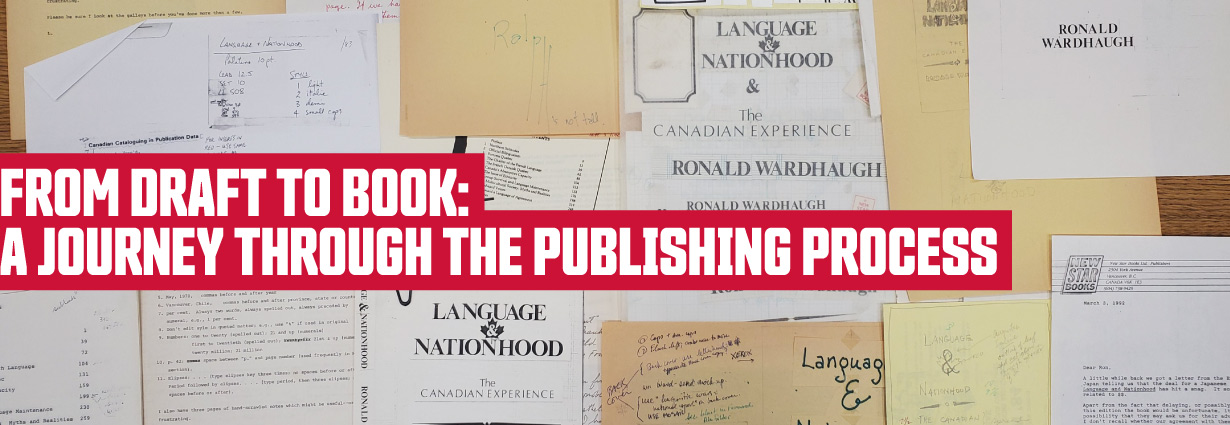
About the exhibit: What is book publishing?
The process of publishing a book involves a series of steps from draft to submission, acquisition, editing, design, printing, sales, marketing, and finally publication.
SFU Library Special Collections & Rare Books is home to a variety of material that represents every stage of the publishing process.
The archival fonds of writers like Eden Robinson, Fred Wah, Lynn Coady, Shani Mootoo, Michael McClure, Lisa Robertson and many more include early drafts of published poetry and fiction.
The fonds of publishers like Douglas and McIntyre, Barbarian Press, New Star Books, Nightwood Editions, Talonbooks and other offer example of the business activities of a publisher and the journey of a work from submission to publication.
On exhibit are examples from a range of holdings representing the process of publishing a physical book.
What's on display
Visit the Special Collections exhibit: Indigenous Storytelling from the Lutz Collection (September to December 2023)
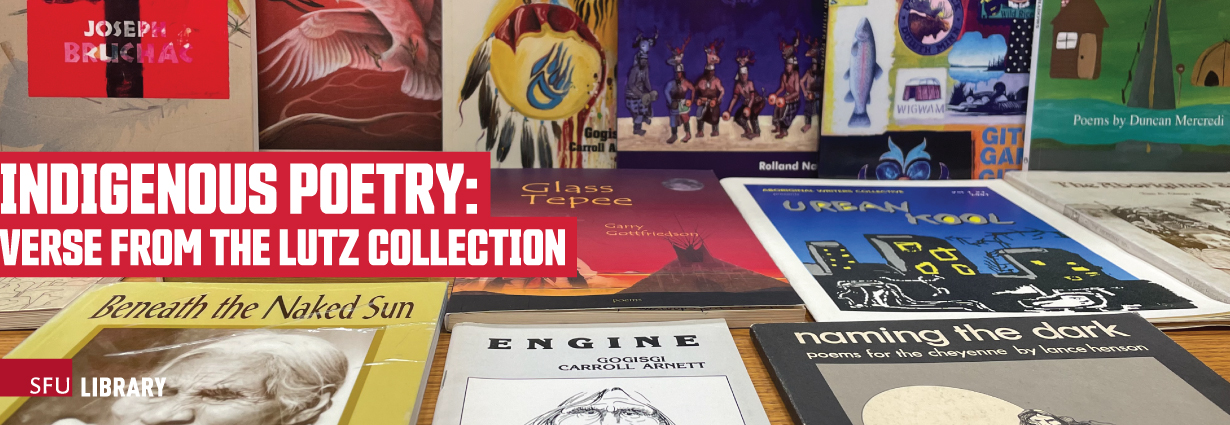
What's on display
The exhibit includes:
- Stories and their adaptations of the California Nations, Navajo and Cherokee peoples;
- Stories featuring Coyote (a common character of Indigenous stories, teaching the young about acceptable behaviour while Coyote shifts between traits of Trickster, Helper, Teacher or Fool);
- Song of Heyoehkah by Hyemeyohsts Storm, a novel that combines the form of traditional teaching stories with the Western style fiction;
- Collection of stories representing Anishinaabe (Ojibway), Nēhilawē (Cree, Atikamekw) and Niitsítapi (Blackfoot) peoples heritage;
- Stories of Haudenosaunee (Iroquoian) and Kanien'kéhaka (Mohawk) peoples;
- Stories of Indigenous peoples from the West Coast represented by Stó:lō peoples.
About the collection
The Hartmut Lutz Collection of Indigenous Literature contains over 1000 books by Canadian and American Indigenous authors and on Indigenous subjects.
Hartmut Lutz is professor emeritus and former chair of American and Canadian Studies: Anglophone Literatures and Cultures of North America at the University of Greifswald, Germany. He is founder of the Institut für Anglistik und Amerikanistik, a research centre for Canadian and American literature studies. Over the course of his career, much of Dr. Lutz’s research has focused on Canadian culture and Indigenous literature.
Experience the Power of IMAGeNation: materials from the Indigenous Media Arts Group archive (September to December 2023)
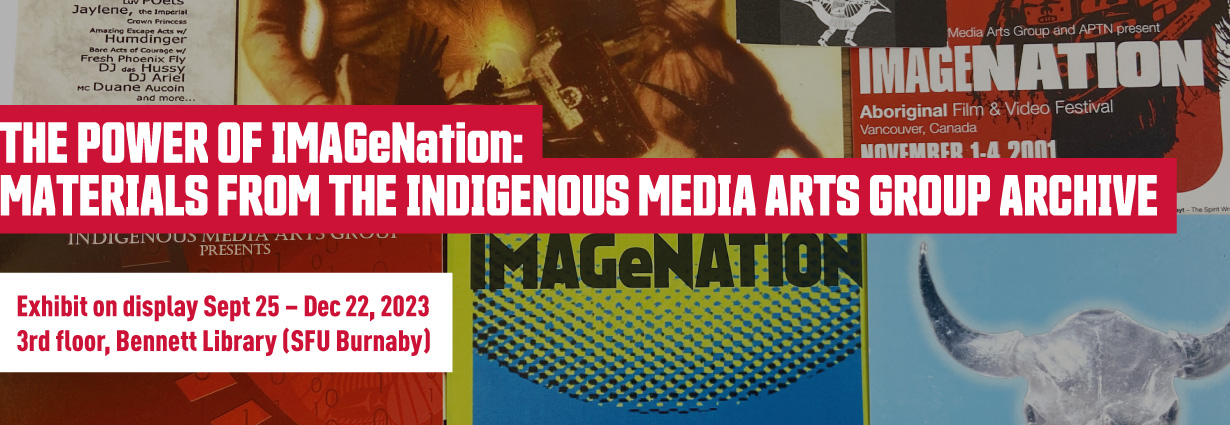
About the exhibit: The Power of IMAGeNation: materials from the Indigenous Media Arts Group archive
The Indigenous Media Arts Group, or IMAG (pronounced “image”), was a Vancouver-based organization founded in early 1998 to promote the development and dissemination of Indigenous media, arts, and culture.
IMAG organized the highly successful IMAGeNation Aboriginal Film and Video Festival, which was held annually in Vancouver from 1998 to 2006. Early festival included works produced, written or directed by Indigenous media makers from Canada. By the 2000s, the festival received submissions from Indigenous media makers from around the world.
In order to bring Indigenous film to rural communities in British Columbia, IMAG organized a traveling film festival that was held in Prince Rupert, Duncan and Enderby in 1999 and 2005.
Members of IMAG facilitated workshops and training programs in media and administration, and operated a resource centre for Indigenous people, access information about media arts, and equipment for film and video making.
IMAG held its first media training program in 2000 and continued to offer training in subsequent years, including themed training programs, such “Healing Hands: Voices of Resistance” and “Repatriation: Returning Home” in 2004-2005.
What's on display
The exhibit includes:
- publicity materials
- photographs
- film festival programs
- materials related to the administration of the organization
- objects, including a t-shirt and an award!
Material is selected from:
Want to view more materials from the collection? Check out the IMAGeNation digitized collection on SFU Digital Collections!
2022 exhibits: Depicting Dante; Writing Canadian Women; CUPE BC; Bindings and Beyond; bpNichol; Diaries; Indigenous Poetry
View Depicting Dante: The Divine Comedy in Book Art and Illustration (January to March 2022)
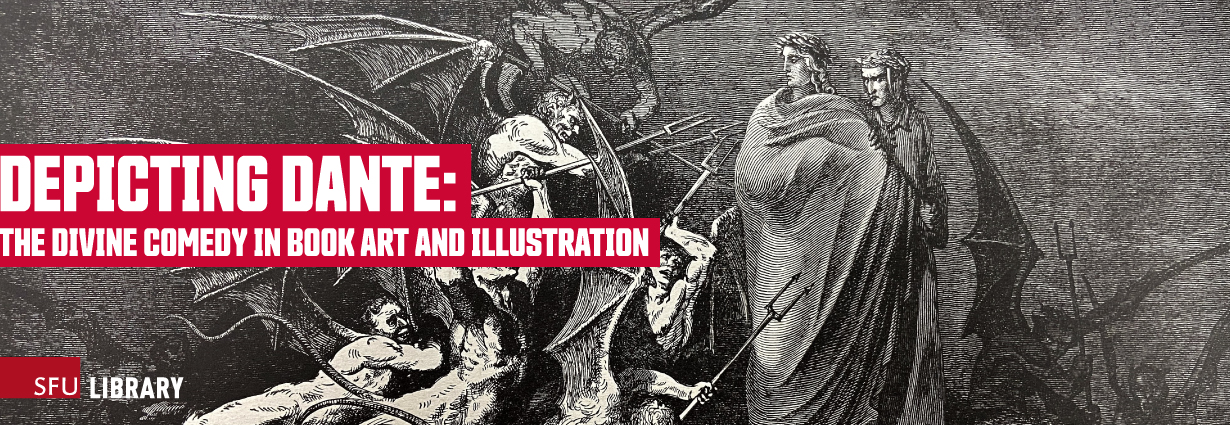
About the exhibit
Special Collections and Rare Books is pleased to feature an exhibition of art and book illustrations inspired by Dante's The Divine Comedy, in commemoration of the 700th anniversary of Dante’s death.
Visit the Special Collections exhibit: Writing Canadian Women (Write) Out of the Archive (March to April 2022)
About the exhibit
For this exhibit, six participants—Pantea Fard, Robin Mitchell Cranfield, Linda M. Morra, Donald Shipton, Olivia Visser, and Angela Wachowich—were invited to choose one woman writer in Canada whose archive is located at Simon Fraser University Library Special Collections and Rare Books. The scope may have been vast in view of the extensive holdings of this institution, but each of the six responses was crafted in response to a more narrowly focused archival specimen currently featured in this exhibit. The materials selected consistently emerged from a woman writer’s archive from the late twentieth century up to a more recent moment and included Lisa Robertson, Eden Robinson (Haisla/Heiltsuk), Anita Rau Badami, Ann Diamond, and Shani Mootoo.
The materials exhibited for Writing Canadian Women (Write) Out of the Archive render clear how the archive may extend and shape our understanding—about a woman writer’s writerly aspirations, literary strategies, and oeuvre; about the political commitments and contexts that inform and give rise to the very form the materials assume; and about the kinds of private contradictions that might not otherwise be visible to public readers of their books. Being in the archives allows for a more privileged appreciation, which this exhibit means to share with a wider audience. These archival materials enrich our understanding of the range of and limits to literary practices and to fomenting political contexts that render authorial intentions more clear—or, at times, more complex.
The challenges the participants encountered were immediately apparent by the questions the materials themselves posed: To what were these archival materials responding? What about women writers who were identified as “Canadian” in various media outlets but did not self-identify as such? How did media outlets contradict more personal or private assessments of authors and what were the implications? What about the more uncanny elements of the archived materials about which women writers may not have been initially aware, only grasping more fully the narrative they had captured at the time the archive was established? How conscious were these women writers of the kind of power to which they were laying claim as expressed through their work—and through the archive?
Discover Visible Labour, a Special Collections exhibit (May to August 2022)
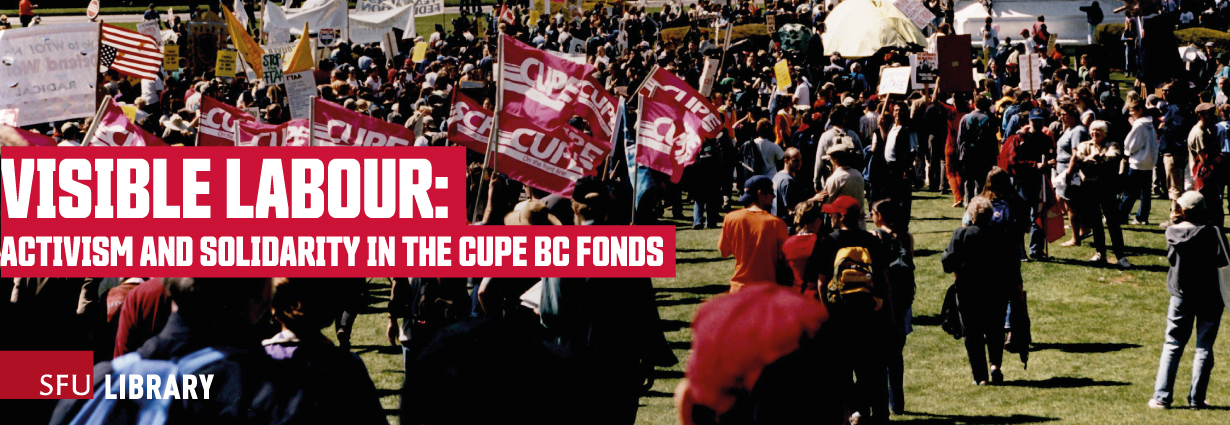
What's on display?
The fonds includes:
- Early NUPE (National Union of Public Employees) records
- Convention proceedings, committee reports, agendas and resolutions
- Transcripts and cassettes from the 1960s to 2000s
- BC division Executive Board meeting files and recordings
- BC Federation of Labour Convention proceedings (1980-)
- Canadian Labour Congress convention materials
- CUPE National Convention materials, president’s papers
- Papers of past presidents and secretary-treasurers
- Newsletters, bulletins and other periodicals, campaign materials, and banners and flags.
What is CUPE B.C.?
CUPE, labour, and activism
Visit the Special Collections exhibit: Binding and Beyond: Modern Book Design and Decorative Elements (June to August 2022)
What's on display
The exhibit includes:
- Book bindings: goatskin (morocco), various types of calf binding, pig skin, velum, marbled, cloth on board and cosway style
- Page edges styles: trimmed, uncut, marbles, gilded, speckled, painted
- Examples of page gatherings and folio sizes: Folio, Quarto, Octavo, Duodecimo
- Elaborate decorative title page designs featuring use of colour inks, inclusion of printer devices, vignettes and illustrations, and inclusion of half-title pages
- Book illustrations types: engraved or hand painted, in text illustrations, plates, frontispieces, and maps
- Other text decorations and binding elements: chapter initials, head and tail pieces, catchwords and signatures
Further reading
A new introduction to bibliography by Philip Gaskell (1972)
Dictionary of publishing and printing (2006)
Victorian book design and colour printing by Ruari McLean (1963)
Glossary of book binding terms in Publishers' Binding Online, 1915-1930: Art of Books
Explore our two-part exhibition on renowned visual poet, bpNichol (September to November 2022)
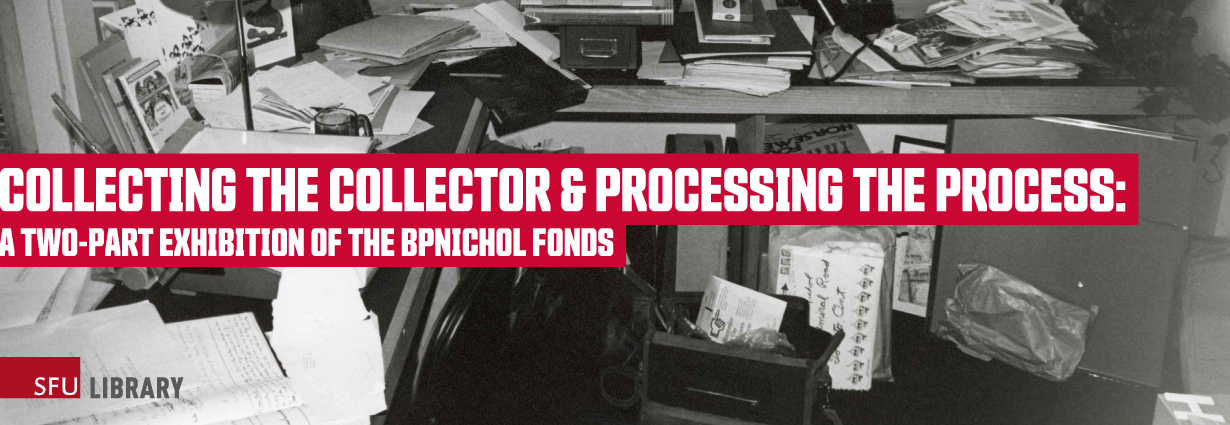
What's on display?
On the third floor of the Bennett Library, materials from Nichol’s various collections are on display. This includes a selection of his robots, instructional manuals for toys, a menagerie of H’s, and selections from his Dick Tracy comic book collection—all alongside other playful projects found in his archives. Together, these highlight the diverse media in which he found inspiration for his genre-blending literature.
Displayed on the seventh floor, at the entrance to Special Collections and Rare Books, is an exhibition centering Book 5 of The Martyrology, one part in a series that Nichol worked on for well over a decade. From conception to draft, to proof, to publication, the various archival documents on display track the production of this seminal text. If the exhibition at the library’s entrance focuses on what Nichol sourced for inspiration, the motivating question of this second part is how: how he organized his ideas, and how he brought them to bear upon the page.
Visit both displays to learn more about bpNichol’s creative process and to view selections from his diverse archival collections!
About the curators
Donald Shipton is an MA student in the Department of English at Simon Fraser University. His scholarly interests reside primarily in contemporary Canadian literature and the archive. He is currently studying the chapbooks and ephemera of bpNichol, held in the Contemporary Literature Collection at SFU, with particular attention to their materiality and the possibility of replicating this in digital space.
Emma Metcalfe Hurst is a writer, curator, and researcher who is currently in her third year studying archives and librarianship (MASLIS) at the UBC iSchool. Her areas of interest include community, artist, and performing arts archives, public programming, and intellectual property rights. She has previously worked at Access Gallery, Nanaimo Art Gallery, grunt gallery, Western Front, Artspeak, Unit/Pitt, Co-op Radio, the UBC Music, Art, and Architecture Library, and the Museum of Anthropology. She recently launched the oral history and community archives project, Coming Out of Chaos: A Vancouver Dance Story, and was the project coordinator for Recollective: Vancouver Independent Archives Week. She is currently working as an archivist for VIVO Media Arts Centre and Karen Jamieson Dance.
Explore our exhibition on diaries and journals (November 2022 to March 2023)
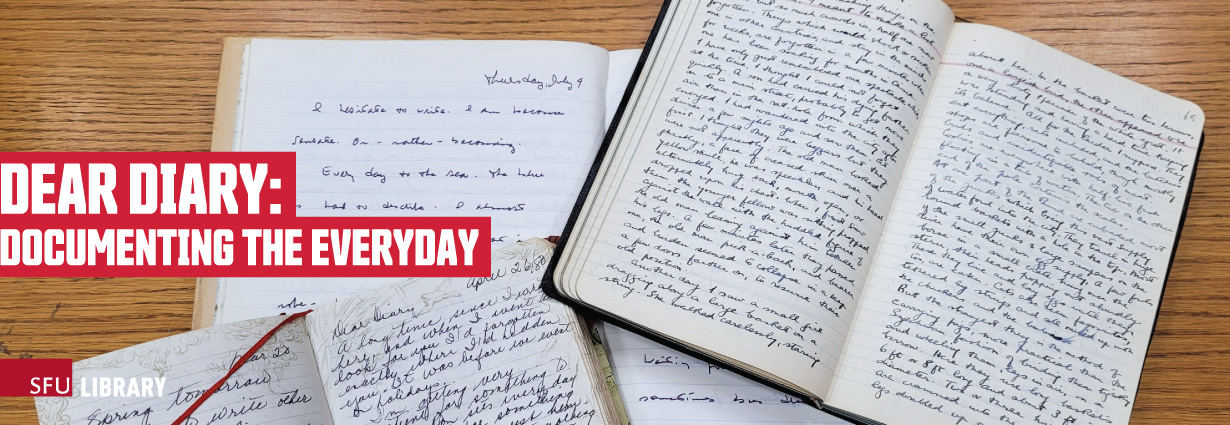
View Dear Diary: Documenting the Everyday, on display on the 7th floor at W.A.C. Bennett Library.
What's on display?
This exhibition features a selection of diaries and notebooks from across Special Collections and Rare Books. It explores different genres of diary, including travel diaries, diaries by incarcerated people, poetic diaries, dream diaries and everyday diaries.
Included in the exhibit are items from the following:
- a poetic diary from poet Fred Wah's archive
- a travel diary and scrapbook from journalist Harrison Brown's fonds, documenting his 1937 visit to China
- prison diaries kept by a 'Son of Freedom' from the Doukhobor collection
- a travel journal with polaroid photographs from playwright Betty Lambert's fonds
- a prison account from 71-year-old activist Betty Krawczyk's fonds
- detailed, daily diaries from the Allan Grant and Ethel Moxon collection, and
- a dream journal from writer Mary Billy's fonds
Visit the Special Collections exhibit: Indigenous Poetry: Verse from the Lutz Collection (November 2022 to April 2023)

What's on display
The exhibit includes:
- Compilations, edited works and works by Aboriginal Writers Collective
- Algonkian authors: Jack D. Forbes, Joseph Bruchac, Rolland Najiwon
- Anishinaabe (Ojibwa, Ojibwe) poets: Kimberly Blaeser, Kateri Akiwenzie-Damm
- Nēhilawē (Cree, Atikamekw) poets: Anne Acco, Connie Fife
- Kanien'kéhaka (Mohawk) poet: Maurice Kenny, E. Pauline Johnson, Peter Blue Cloud
- Métis poets: Duncan Mercredi, Leonard Carriere
- Cheyenne poet: Lance Henson
- Osage poet: Duane Big Eagle
- Pueblo poets: Wendy Rose, Dawakema and Kewanhongnaya, Simon J. Ortiz
- Cherokee poets: Gogisgi / Carroll Arnett, Geary Hobson
About the collection
The Hartmut Lutz Collection of Indigenous Literature contains over 1000 books by Canadian and American Indigenous authors and on Indigenous subjects.
Hartmut Lutz is professor emeritus and former chair of American and Canadian Studies: Anglophone Literatures and Cultures of North America at the University of Greifswald, Germany. He is founder of the Institut für Anglistik und Amerikanistik, a research centre for Canadian and American literature studies. Over the course of his career, much of Dr. Lutz’s research has focused on Canadian culture and Indigenous literature.
2021 exhibits: Early writing materials and technologies; Henry James; Wood engravings
Visit the Special Collections exhibit: Dutton Collection of Early Writing Materials and Technologies (September to October 2021)
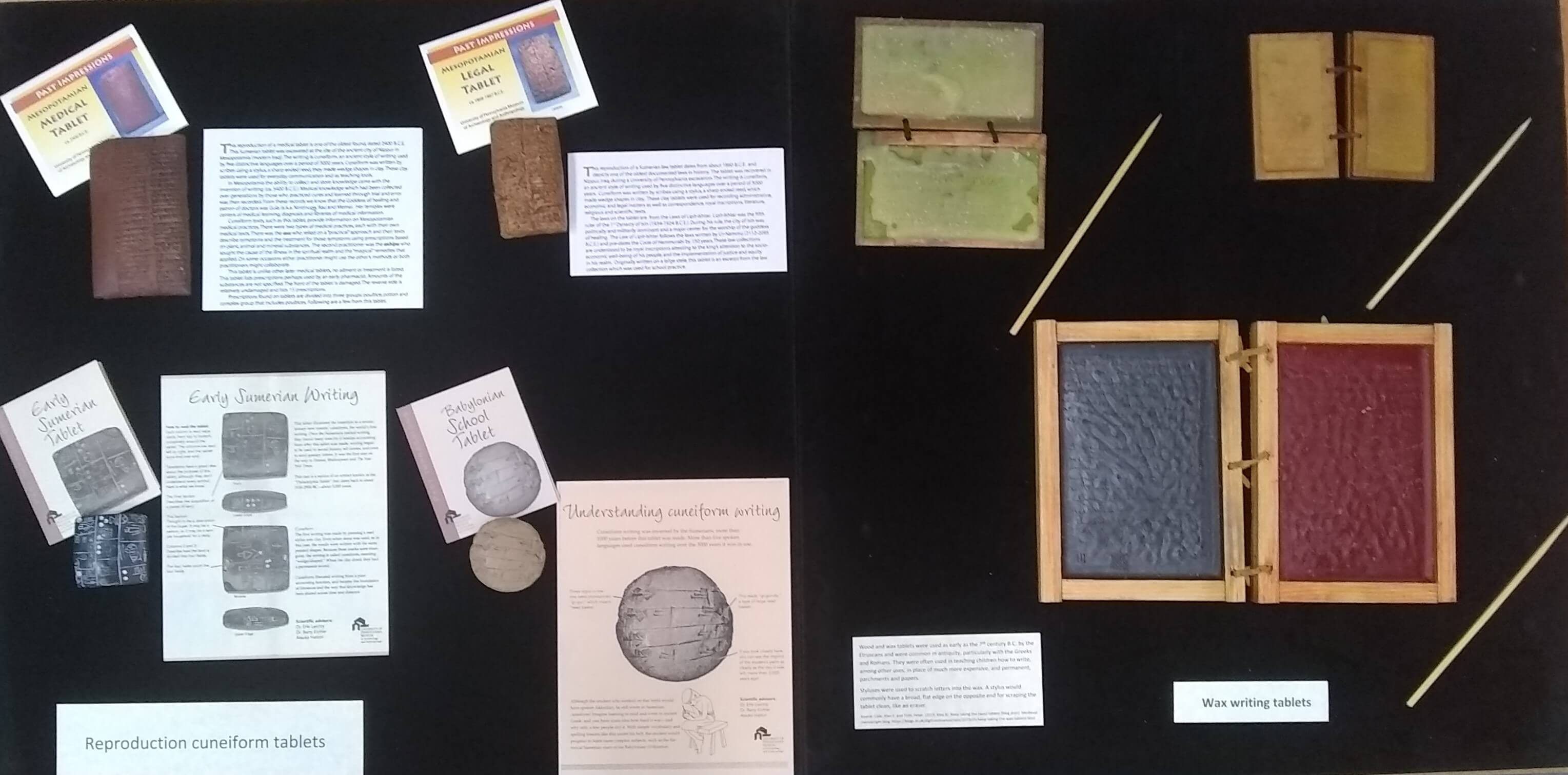
This exhibit features items from the collection of emeritus faculty member Paul Dutton. The collection reflects Paul’s interest with the materiality of writing systems; this provides some important context to our book history holdings.
Visit the Special Collections exhibit: Dr. Paul Delany Donation of Works by Henry James (November to December 2021)
About the exhibit
Special Collections and Rare Books is pleased to have recently acquired a collection of 55 first and early editions of books by the American-British writer Henry James (1843-1916).
Visit the Special Collections exhibit: Wood Engravings as An Art of Book Illustrating (November 2021–February 2022)
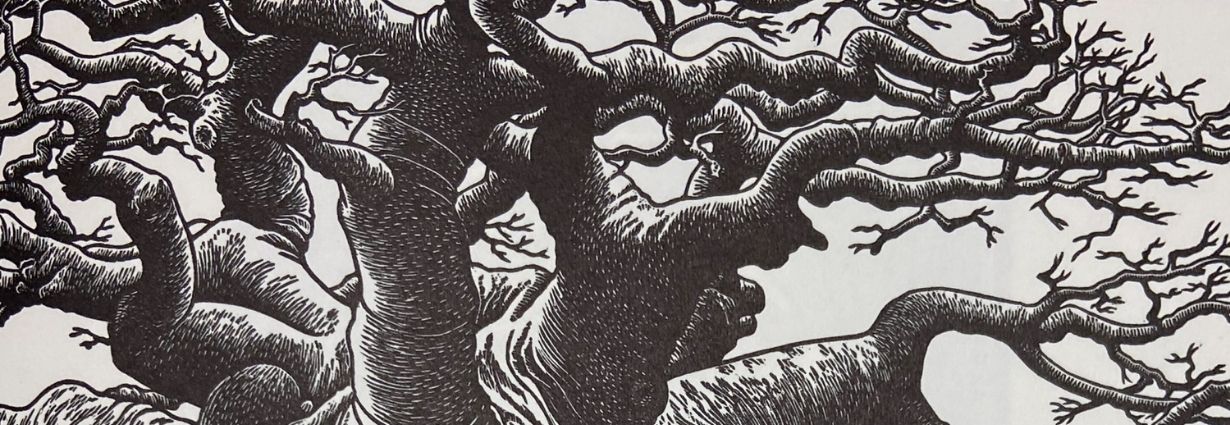
About the exhibit
This exhibit features a selection of books decorated with wood engraving techniques. The exhibit traces the revival of the engraving as an artful technique of book illustrating in the nineteenth century after it faded away in the sixteenth century.
The renewed interest in this technique was promoted by Thomas Bewick and William Blake and many followed, including many women artists.This type of artful illustration lost its popularity again in the twentieth century, largely replaced by photography. The wood engraving method was picked up once more in the twenty-first century by the small press establishments that refined wood-engraving methods resulting in an exquisite art form.
What's on display
The exhibit includes:
- Wood engraving history including William Blake’s attempt at creating such illustrations
- Wood engraving methods - presenting a contemporary example of wood-engraving process of Venus and Adonis by Andy English
- Wood engraving illustrations by naturalist Thomas Bewick
- Women engravers including Clare Leighton, Gwendolen Reverat, and Agnes Miller Parker
- Modern engraving by small presses featuring B.C.'s own Barbarian Press
- Evolution of woodcut to linocut illustrations featuring Jim Rimmer’s linocut blocks used in illustrating of Shadow river: the selected and illustrated poems of Pauline Johnson.
2020 exhibits: BC fine and private presses; Fairy tales and fables
Visit the Special Collections exhibit: A Decade in British Columbia — Fine and Private Presses (January to February 2020)
We are displaying a small sample of our Book Publishing and Book Arts collections, including monographs and ephemera created by fine and private presses in British Columbia throughout the 2010s, with an emphasis on on book design, typography, illustrations, covers, paper making, and paper choices.
Featuring the work of many talented designers, printers, photographers, papermakers, bookbinders, and artists over the last decade, this exhibit highlights the attention to detail and collaboration required to create these limited editions. After the exhibit, readers may consult these titles in the Special Collections and Rare Books reading room (Room 7100).
What's on display
The exhibit includes a selection of limited edition books and ephemera, featuring fine press catalogues, prospectuses, invitations, and more, including:
- Lead, tin & antimony: specimens of metal type held in cases or cast fresh at the Greenboathouse Press, a showcase monograph for rare and freshly-cast types, and A selection from the meditations of Marcus Aurelius, sort of, by Jason Dewinetz (Greenboathouse Press).
- Cutting paper and Around the world in colour : a multi-hued tour of rocks & bugs, by Claudia Cohen & Barbara Hodgson (Heavenly Monkey)
- Atlantic Canada : contagiously mournful / photography and BASH poetry, and Conjoin : to come together to form a single unit (Merriam-Webster), by Charles Mayrs (Black Stone Press)
- How it goes : a convocation address, by Robert Bringhurst, Richard Wagener : a dialogue with wood engraving, and Between rainfalls, by Tim Bowling (Barbarian Press).
View the Fairy Tales and Fables Exhibit (January to February 2020)
This exhibit features a selection of fairy tales and fables mostly published in the nineteenth and early twentieth centuries, with stylish illustrations and eye-catching covers to capture readers' interest. After the exhibit, readers may consult these titles in the Special Collections and Rare Books reading room (Room 7100).
2019 exhibits: Rocking against Radiation; Venetian Renaissance illustration
"Rocking against Radiation and Dancing for Peace: Anti-war and Peace Activism in B.C." (April to December 2019)
Saints, Sinners and Souvenirs in Venetian Renaissance Illustration (September to November 2019)
Currently on display at SFU Library Special Collections and Rare Books is "Saints, Sinners and Souvenirs in Venetian Renaissance Illustration,” an exhibition showcasing highlights from SFU Library’s Wosk-McDonald Aldine Collection. The exhibition, curated by Ralph Stanton, former Head of Special Collections and Rare Books at SFU, is a themed collaboration with the Burnaby Art Gallery. The BAG’s exhibition, entitled "Saints, Sinners and Souvenirs: Italian Master Prints and Drawings from Western Canada", features Italian Master prints and drawings from Vancouver-area public and private collections. The exhibitions run until November 17. A catalogue featuring essays by Ralph Stanton, guest curator Dr. Hilary Letwin and Dr. Julian Brooks is available.
In his essay published in Festina Lente: A Celebration of the Wosk-McDonald Aldine Collection at Simon Fraser University (1996), Dr. Yosef Wosk noted that, “Gutenberg may have developed mass production moveable type for the Western printing press, but Aldus developed the moveable book.” Thanks to the interest of Publishing@SFU and the skill of the Library’s Digitization Centre, more than 40 titles from the Wosk-McDonald Collection have been digitized. These titles can be consulted from the Library’s digital collections as well as from a prototype interpretative website. We’d like to think that Aldus himself would approve of such innovative efforts to make his editions more portable to every kind of reader.
SFU Library is grateful to the University of Manitoba Archives and Special Collections for a loan of Hypnerotomachia Poliphili for this exhibition. We are grateful to the authors Ralph Stanton, Dr. Hilary Letwin, and Dr. Julian Brooks whose words provide the foundation for these collaborative exhibitions. We also acknowledge the continued generosity of donors, especially Jerry, Daniel, David, and Kini McDonald and Ralph Stanton and Dr. Sabine Mabardi who recently enabled us to purchase more Aldines to enhance our already magnificent collection.
2018 exhibits: Women of Wordsworth
View the new "Women of the Wordsworth Collection" exhibit (August 2018)
Special Collections and Rare Books is pleased to announce a new exhibit on the "Women of the Wordsworth Collection" curated by Kate Moffatt, an MA student in the Department of English. Located on the third floor of the W.A.C. Bennett Library until August 31, 2018, the exhibit was developed through in-depth research and analysis of the Library's William Wordsworth Collection undertaken by Moffatt during a Directed Study in Special Collections and Rare Books.
The women in the collection are all related to Wordsworth in some form or another: they are contemporaries from the period, such as Ann Radcliffe; authors of the Lake District, such as Harriet Martineau; or related to Wordsworth himself, as is the case with Dorothy and Dora Wordsworth. But each of these women – along with the others in this exhibit: Helen Maria Williams, Elizabeth Lynn Linton, and Marguerite Gardiner, Countess of Blessington – carry value beyond their reflection of, or relation to, Wordsworth and his works.
Dorothy Wordsworth’s observations of nature in her posthumously published journals compare to (and occasionally inspired) Wordsworth’s; Dora Wordsworth, Helen Maria Williams, and Ann Radcliffe wrote and published journals of their travels through various parts of Europe; the Countess of Blessington published extensively, both travel narratives and novels, as a means of income; and Elizabeth Lynn Linton and Harriet Martineau, both female journalists at various points in their careers, wrote works describing the walking tours of the Lake District and its mountains. Their talents as varied as their lives, these women make up only a small portion of the women writers in the Wordsworth Collection.
This exhibit hopes to introduce you to who these particular women were and prompt, perhaps, a curiosity about the many other accomplished women in both the Collection and the period.
Reflections of the Curator
"Working with the Wordsworth Collection to create this exhibit has been a bit of a dream - I've been studying Dorothy Wordsworth since my undergrad, and women's authorship has always been a focus of mine. There are more than 70 works by women in the Wordsworth Collection, despite its focus on the Romantic poet William Wordsworth, and this exhibit allowed me to really showcase a few of them. It's been a neat experience, working in Special Collections - there's something very magical about touching and working with physical copies of texts that existed when your favourite authors did." -- Kate Moffatt
2017 exhibits: "Allied Arts' Affirmative;" Modern first editions; Canada 150; Student-curated exhibits; Alcuin Society awards
Visit the "Robert R. Reid: ‘Allied Arts’ Affirmative" Exhibition (January to March 2017)
Special Collections and Rare Books is pleased to announce the following exhibition produced by the CAUSA Research Curators, and located on the 3rd floor and 7th floor of the W.A.C. Bennett Library (SFU Burnaby).
A fifth generation Canadian (b.1927), Robert R. Reid, at age fourteen, taught himself to operate a ‘hand press’ –so as to channel his absorbing interest in the practicalities of letterpress printing.
His subsequent association with architects, landscape designers, poets, graphic artists (and editors for magazines and journals) has become emblematic of a post-WWII ‘Allied Arts’ Movement in Canada.
In 1949, in an introduction to the first ‘artisanal’ private press book printed in Canada -- his redesigned edition of Alfred Waddington’s The Fraser Mines Vindicated (1858) -- Reid remarks: “Fine books have literary value … but it is their value as works of art which distinguishes them from other books.” In 1962, he became the first ‘design practitioner’ to be awarded a Canada Council Visual Arts Award.
Having taught printing and graphic design at the Vancouver School of Art [now Emily Carr University of Art and Design], from 1957 to 1962, Reid moved to Montreal. He functioned, there, as Director of Design and Production for McGill University Press. Subsequently, before returning to Vancouver in 1997, he remained active as a freelance designer in New Haven and New York City,
Robert R. Reid’s current practice sustains a digital-experimental typographer’s teleportation presence –and a mindful/regenerative global village aesthetic. In that regard, the present exhibition presents an assemblage of documents generated between 1949 and 2017. Components of the present exhibition will be intermittently replaced (and/or rearranged), in order to maximize the scope of an exploratory curatorial initiative.
About the curators
Developing from affiliations with the Free International University for Creativity and Interdisciplinary Research (as initiated by Joseph Beuys and Heinrich Böll), CAUSA – Collective for Advanced and Unified Studies in the Visual Arts – aims to develop autonomous scholarly analysis and interpretation of visual culture (including problems of intelligibility) within specific historical contexts. CAUSA functions in association with a 'global village' network of independent and institutional scholars – in tandem with a pluralistic community of socially engaged contemporary artists.
Highlights of the Paul Whitney Collection of modern first editions on display (April to May 2017)
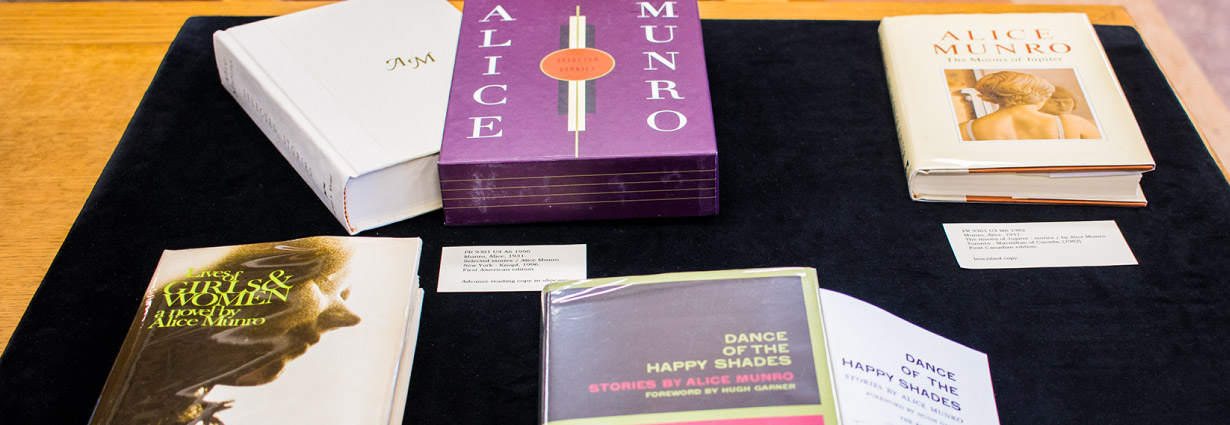
Currently on display outside Special Collections and Rare Books is a selection of recently arrived material from a major collection of modern literary first editions. The collection was donated to Simon Fraser University Library by the former City Librarian of Vancouver, Paul Whitney, a lifelong collector.
The Whitney donation consists chiefly of numerous in-depth collections of the works and various editions of leading modern British, Canadian, American and world writers, including Martin Amis, J.G. Ballard, William Boyd, William Burroughs, Peter Carey, Angela Carter, J.M. Coetzee, Mavis Gallant, B.S. Johnson, Malcolm Lowry, Cormac McCarthy, Ian McEwan, Alice Munro, Haruki Murakami, Rohinton Mistry, Michael Ondaatje, Carol Shields, William Vollmann, David Foster Wallace, and many others.
The collections are comprised of rare and valuable volumes and first editions, including signed and advance copies, as well as more common books. In addition, the donation includes a smaller number of works in translation, plus in-depth collections of several leading literary and fine presses, including McSweeney's (San Francisco), Gaspereau (Nova Scotia), and Blackfish (Vancouver).
Visit the "Celebrating Canada 150: Nineteenth Century First Editions Published on and in Canada" exhibit (May to June 2017)
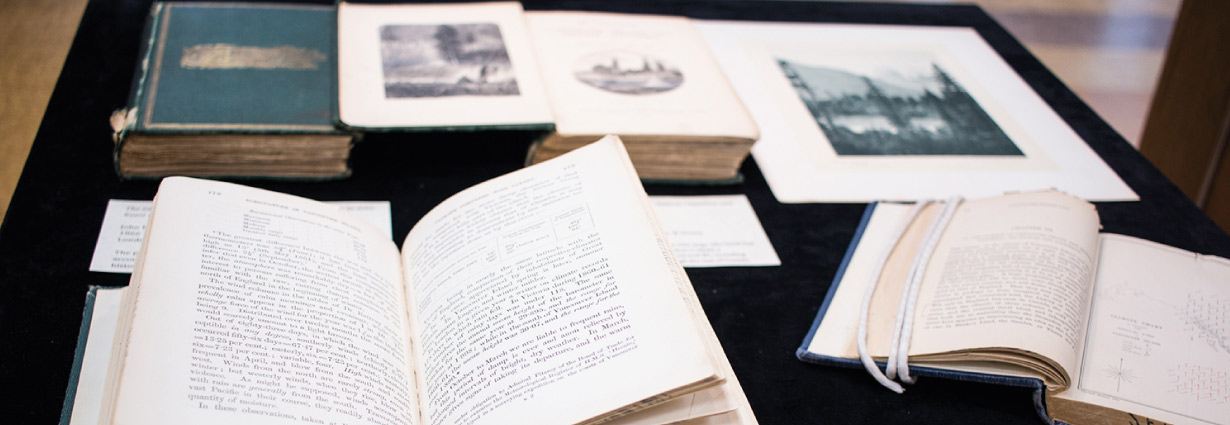
Exploration, the fur trade, the railway… All well-known components of Canada’s history in becoming a nation. This exhibit, by SFU MA Candidate in English Reese Irwin, reflects this past in first edition books published either in Canada, America, or Britain, and showcases a nation on either side of confederation during the nineteenth century. The books date fairly evenly from either side of 1867, with eleven titles pre-confederation and ten after.
All books but two are from the Canadian History Collection within Special Collections, and showcase a range of genres, from fictional narratives to travel writing to railway reports. The publication of these titles in Canada, as well as in Britain and America, demonstrate an increasing interest in Canada, particularly Vancouver Island and British Columbia, as colonies and as places of potential emigration. With this exhibit, Irwin has tried to capture that expansion and how the world envisioned our northern nation in the midst of its formation.
This exhibit was created as part of a Directed Studies in Special Collections and Rare Books course offered through the Department of English.
Visit Special Collections and Rare Books exhibits curated by English 377 (June to August 2017)
Special Collections and Rare Books (SCRB) is pleased to announce two new exhibits curated by English 377 Field School I students (Instructor Michelle Levy) and on display on the third floor of the W.A.C. Bennett Library. Each exhibit focuses on a distinct selection of rare books held by SCRB.
The British Imposition: Eighteenth-Century Exploration Narratives on North American Indigenous Women
Curators: Bernice Puzon, Courtenay Connor, Hannah Guse, Kate Moffatt, Maggie McKoen, Vicky Chio, Zakkiyya Khan for English 377
Poverty in Poetry and Print: Contact between social classes in Romantic era England
Curators: "ENGL 377: The Wordsworth Circle": Grace Chen, Joshua Graham, Gurleen Grewal, Nick McLeod, Tanya Taneva, Joanne Xiao, Carina Yuen
View the 2016 Winners of the Alcuin Society Awards for Excellence in Book Design in Canada (July to August 2017)
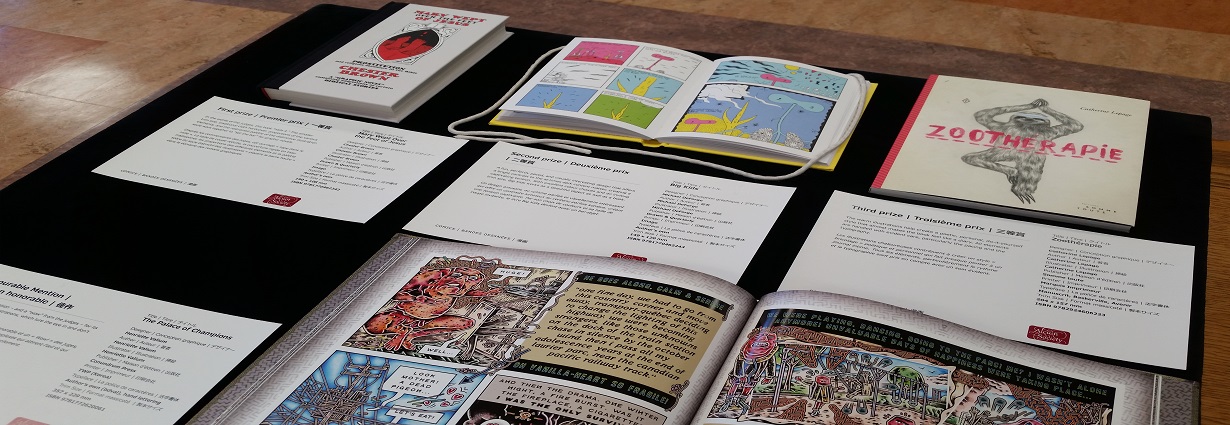
Since 1981, the Alcuin Society has sponsored the oldest competition recognizing fine book design in the country, the Alcuin Society Awards for Excellence in Book Design in Canada. Every year, The Alcuin Society generously donates a selection of the annual award winners to SFU Library’s Special Collections & Rare Books Division. The Alcuin Society Collection is part of our larger Book History Collection. On display is a selection of award winners from the following categories:
- Children
- Comics
- Pictorial
- Poetry
- Prose Illustrated
- Reference
2016 exhibits: Komagata Maru documents; Wordsworth Country; Charles Olson
Komagata Maru documents on display in Special Collections (May 2016)
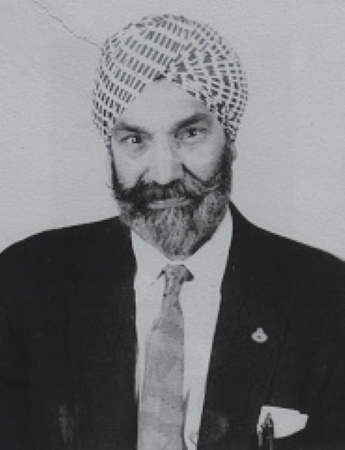
In 2014, nearly 100 years after the Komagata Maru incident, Mr. Amarjit Singh Brar and his family donated to Simon Fraser University Library, Special Collections and Rare Books a suitcase full of his father’s documents, scrapbooks, diaries, photographs and other unique items chronicling the history of South Asians in Vancouver from the time of the Komagata Maru. Arjan Singh Brar originally came to Canada in 1926. An active member of the pioneer South Asian Canadian community, he held numerous roles with the Khalsa Diwan Society at Vancouver’s first Sikh Temple located at 1866 West Second Avenue, and was at the centre of the religious, political, economic and social life of the community.
The Arjan Singh Brar Collection contains many original records documenting the Komagata Maru incident from the local South Asian community and others' perspectives, several of which will be on display at Special Collections from May 16 to May 18. These include:
- Arjan Singh Brar’s diary. Started in the 1920’s, it documents the history of the community beginning in 1904 and ending in 1947. A significant highlight of the diary is its account of the Komagata Maru episode from a South Asian perspective – recorded chronologically is the community’s response to the ship’s arrival, including the activities of the Shore Committee, and events leading to the ship’s eventual departure
- An alternate version of the official Komagata Maru passenger list, written in Punjabi
- Letters from J. Edward Bird, the attorney for the Komagata Maru passengers, to the Khalsa Diwan Society of Vancouver concerning Bird’s correspondence with Gurdit Singh and his son Balwant Singh
- Scrapbooks filled with newspaper clippings documenting early South Asian history in Vancouver, in particular the Komagata Maru incident
To learn more about the Komagata Maru incident and to view related material visit the SFU Library's website Komagata Maru: Continuing the Journey.
Visit the "Wordsworth Country: The English Lake District and the Pacific Northwest" Exhibition (June to October 2016)
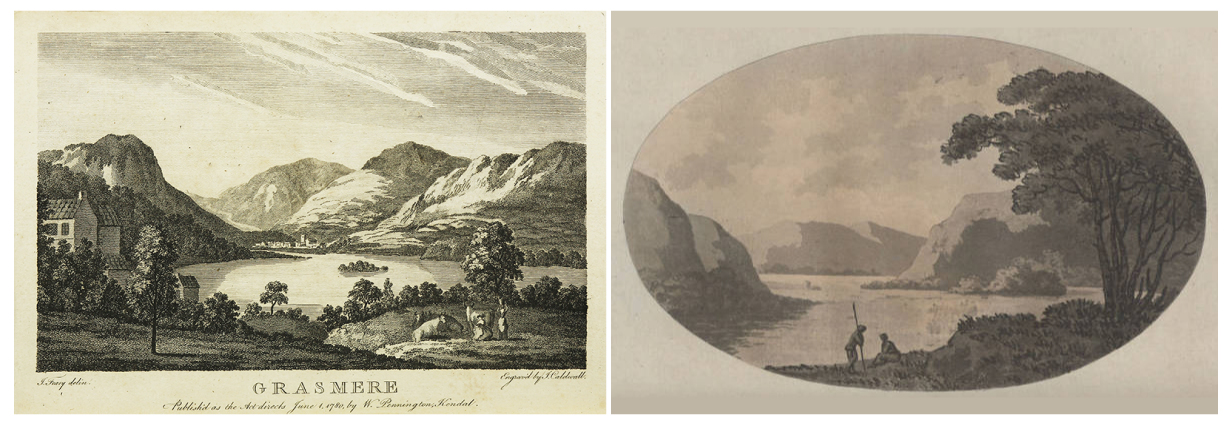
This joint exhibition with the Wordsworth Trust celebrates the 50th Anniversary of Simon Fraser University and is inspired by the Lake District as a renowned cultural heritage site and popular tourist destination.
Curated by Dr. Margaret Linley and her team, the exhibition explores the enduring impact of the life and writings of William Wordsworth on the Canadian Pacific Northwest’s literary and visual responses to nature. It showcases a range of Lake District travel writing, poetry and rare postcards from SFU Library’s Special Collections.
Comparisons between the Lake District and British Columbia landscapes reveal how the remarkable influence of ideas that would eventually be associated with Wordsworth Country travelled the globe. In particular, we explore Wordsworth’s call to preserve and sustain what we now call “green space” for all to enjoy.
The exhibition is located at the W.A.C. Bennett Library -- on the 3rd floor and in Special Collections & Rare Books, Room 7100. An online version of this exhibition is also available on the Lake District Online website, a bibliographic database and digital archives aimed at studying book ecology and migrating collections in a global context.
View a selection of volumes from the Ralph Maud Collection of Charles Olson's books in Special Collections (November to December 2016)
In preparation for this book and subsequently spurred on by it Maud began to reconstruct and replicate Olson's library, the original of which is with the poet's archive at the University of Connecticut. Over time the 'Ralph Maud Collection of Charles Olson's Books' grew to more than 4,000 volumes, quite a few of them including Olson's annotations, which Maud painstakingly copied from the originals into the 'replica' books.
Although the collection was largely comprised of copies it also included a number of 'originals', i.e. books that the poet had in fact owned and in many cases signed, inscribed, annotated, jotted notes in, and in at least one case outlined one of his books in. Maud donated his Olson 'originals' to Bennett Library's Special Collections & Rare Books Division over the past decade, while the larger 'replica' library is now housed in the poet's hometown of Gloucester, MA by the local writer's center.
Recently the SFU volumes have been catalogued and placed in the Library's Contemporary Literature Collection, a large special collection of modern English-language avant-garde poetry with Olson at its center that Dr. Maud himself founded upon his arrival at SFU. The display will be featured until December 23.
2015 exhibits: Thank you to donors; Robin Blaser; Komagata Maru; William Morris
Special Collections and Rare Books thanks donors (July to August 2015)
Every year Special Collections and Rare Books received donations of books and manuscripts. These donations help the University support its missions of research and teaching, and the donated items can be securely housed as a valuable legacy for future scholars.
Special Collections and Rare Books thanks our donors for entrusting us with their donations. Thank you very much!
A selection of the donations received in the past year is currently on display in the Special Collections and Rare Books cases on the third floor of the W.A.C. Bennett Library, SFU Burnaby.
Shown is one of the images on display, taken from the Pacific Tribune Photograph Collection.
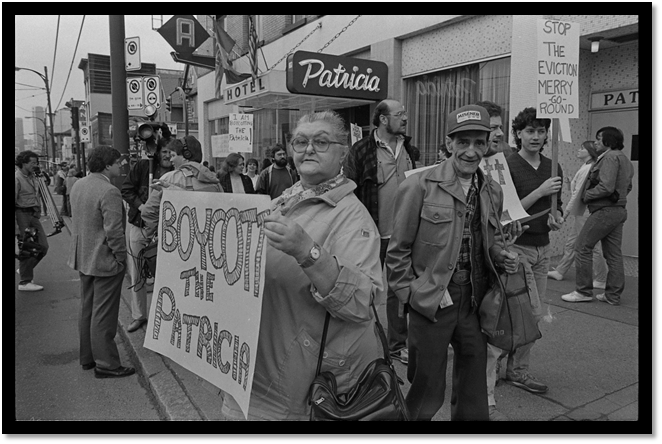
Visit the Robin Blaser display and learn about this captivating poet, editor, and essayist (September to October 2015)
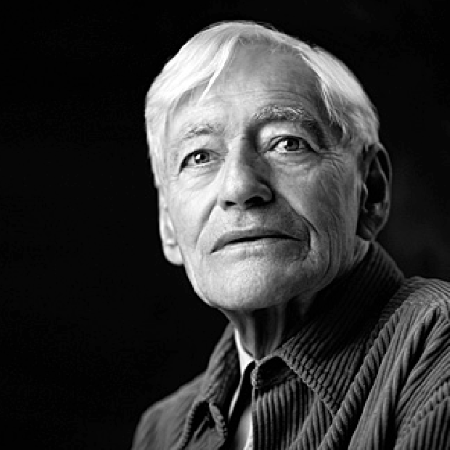
Former SFU professor Robin Blaser (1925-2009) came north to Vancouver from San Francisco in 1966 to join the newly established SFU English Dept. He taught at the university for two decades, during which time he proved a charismatic and inspiring teacher, as well as a practicing poet, editor and essayist with a steadily rising international reputation.
As part of the 50th Anniversary celebration Bennett Library's Special Collections & Rare Books Division has mounted a display on Blaser's life and work. Materials are drawn from the extensive Blaser archive, housed in the Contemporary Literature Collection of Special Collections and Rare Books.
Visit the exhibit: Komagata Maru & beyond: A cultural history of Indo-Canadians (September to October 2015)
Robert Coupe Collection of works by and about William Morris (December 2015)
In November 2015, the SFU Library recognized the generous donation by Dr. Robert and Rosemary Coupe of an extensive and significant collection of rare books, pamphlets and other items by and about William Morris.
Collector Dr. Robert L. M. Coupe
Inspired by Philip Henderson’s biography of William Morris in the early 1970s, Dr. Robert Coupe purchased his first Morris book -- a new edition of Cupid and Psyche -- approximately forty years ago. Over the intervening decades, he visited book fairs and rare book shops, acquired the services of book dealers locally and internationally and, eventually, used the internet to build up an extraordinary and comprehensive collection of well over 1,000 items either by or relating to William Morris.
Dr. Coupe’s interest in the illustrated editions of Morris’ work led him to write his own book Illustrated Editions of the Works of William Morris in English published by the Oak Knoll Press and British Library in 2002. A second edition was published in 2011.
Collection highlights
Dr. Coupe's collection represents the diverse range of William Morris' activities as a writer, typographer, and socialist activist. Some of the highlights of the collection include:
- An extensive collection of volumes published by Morris' Kelmscott Press, including multiple editions of some of the works
- Rare pamphlets and books relating to Morris' socialist activities
- Copies of Morris' Icelandic saga translations

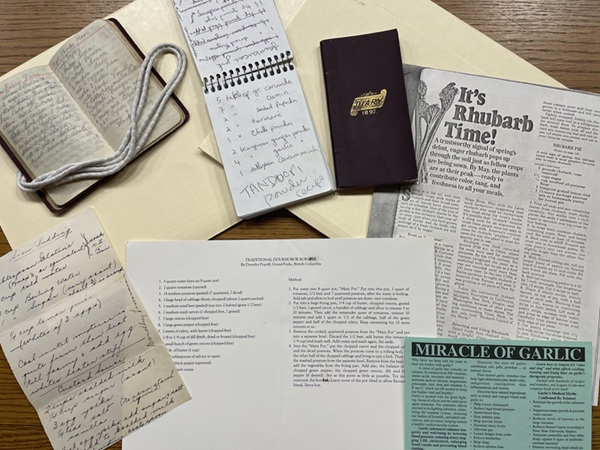
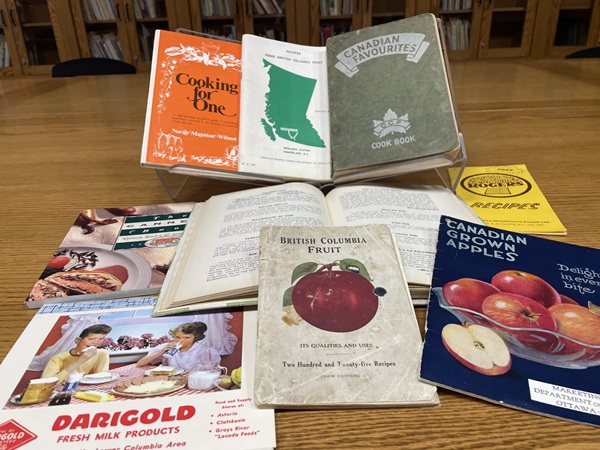
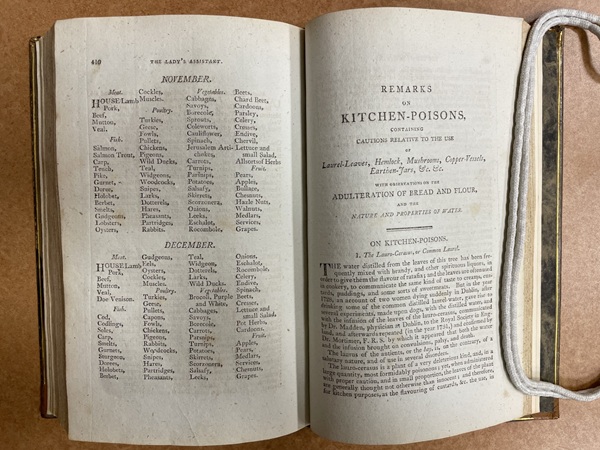
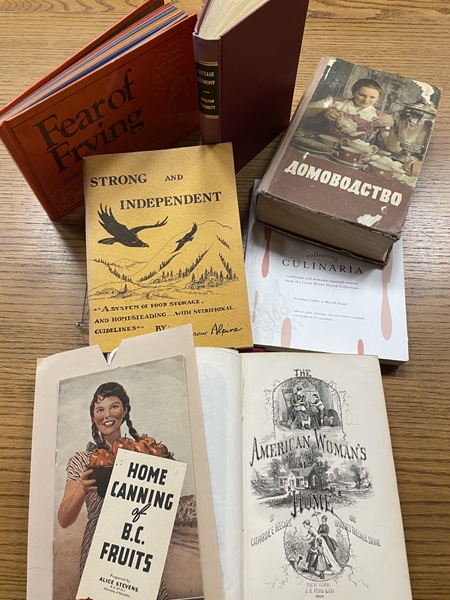
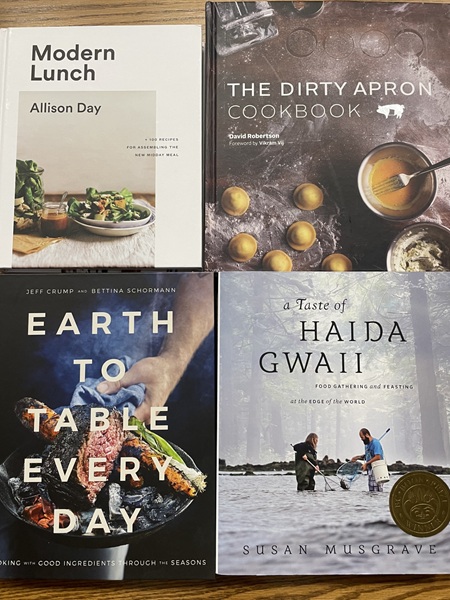
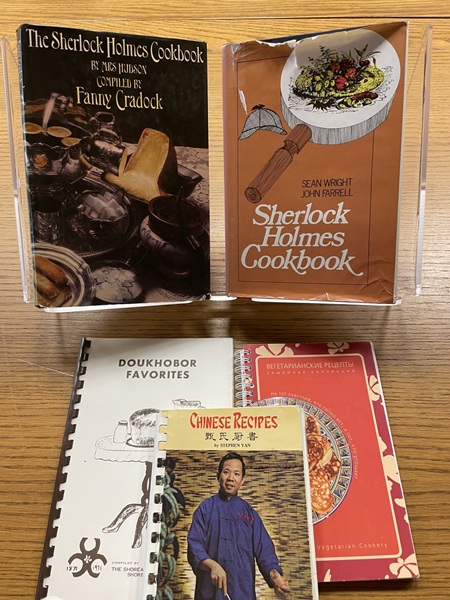
![Clockwise from top: Plant this book by Richard Brautigan; Death and Trauma by Rob McLennan; [The worm is devoted to digestion] by Mark Laba](/system/files/34828/seed_worm_dirt.jpg)
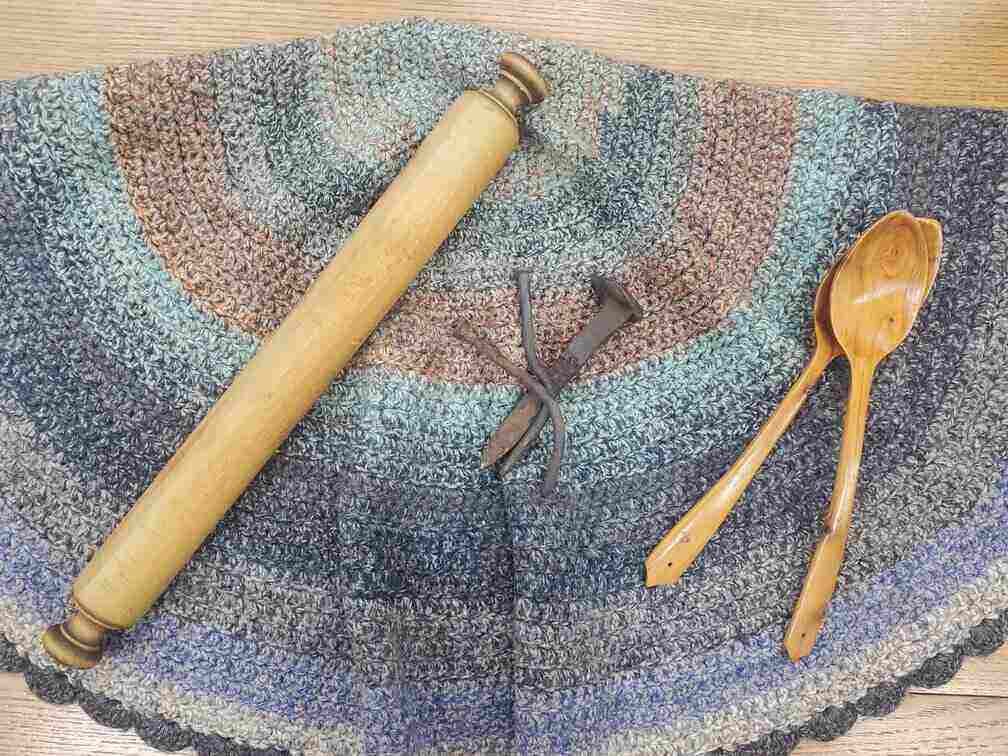
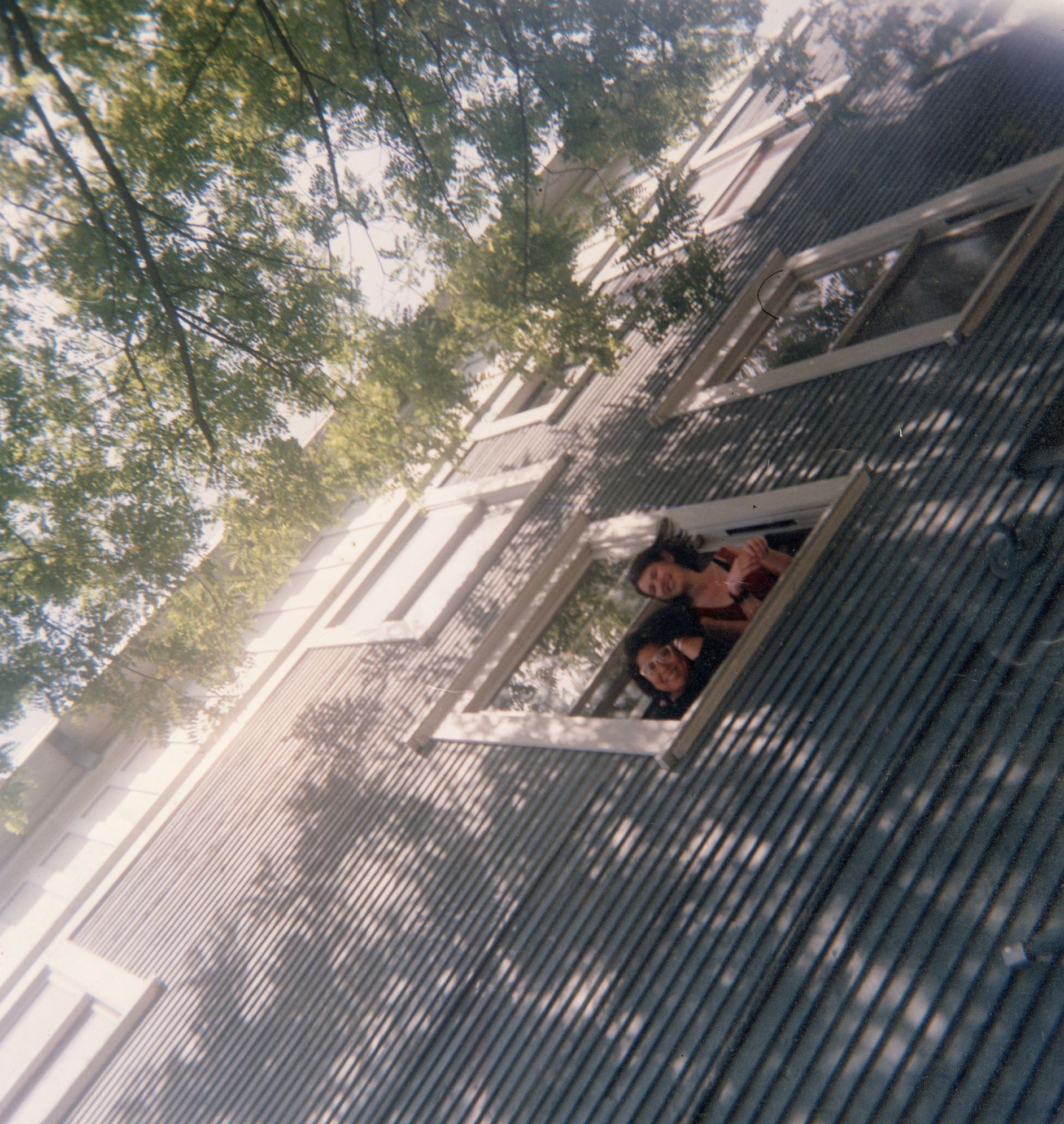
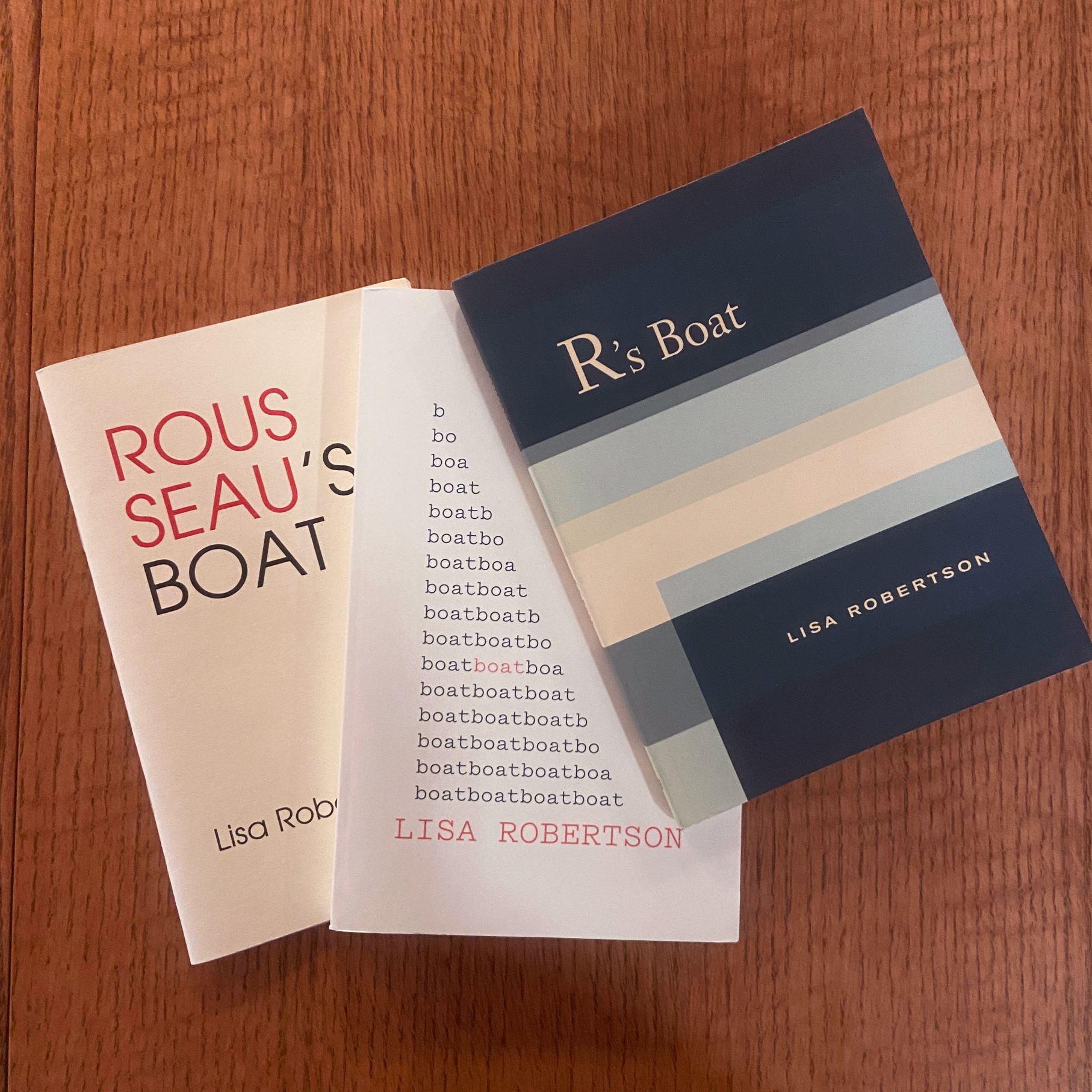
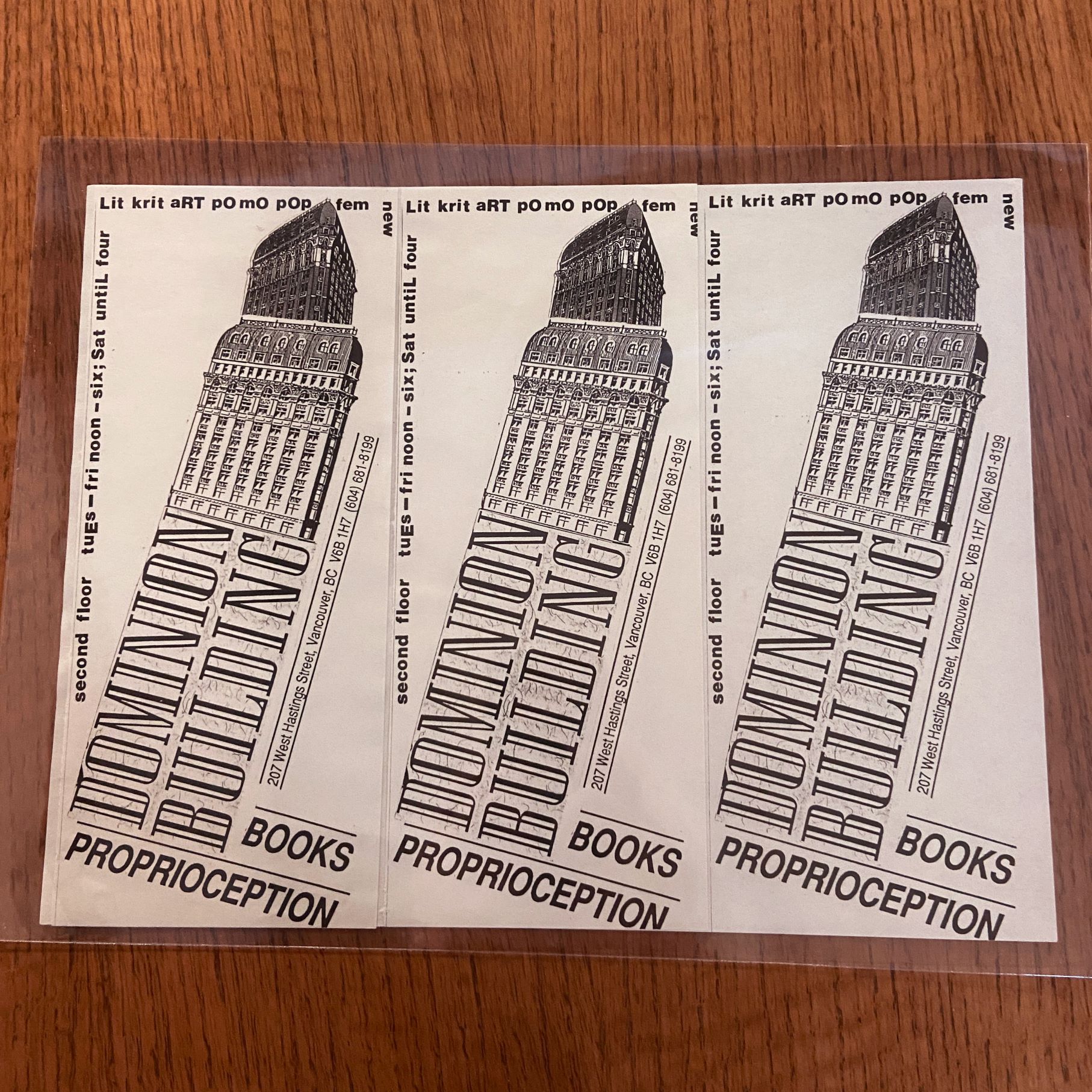
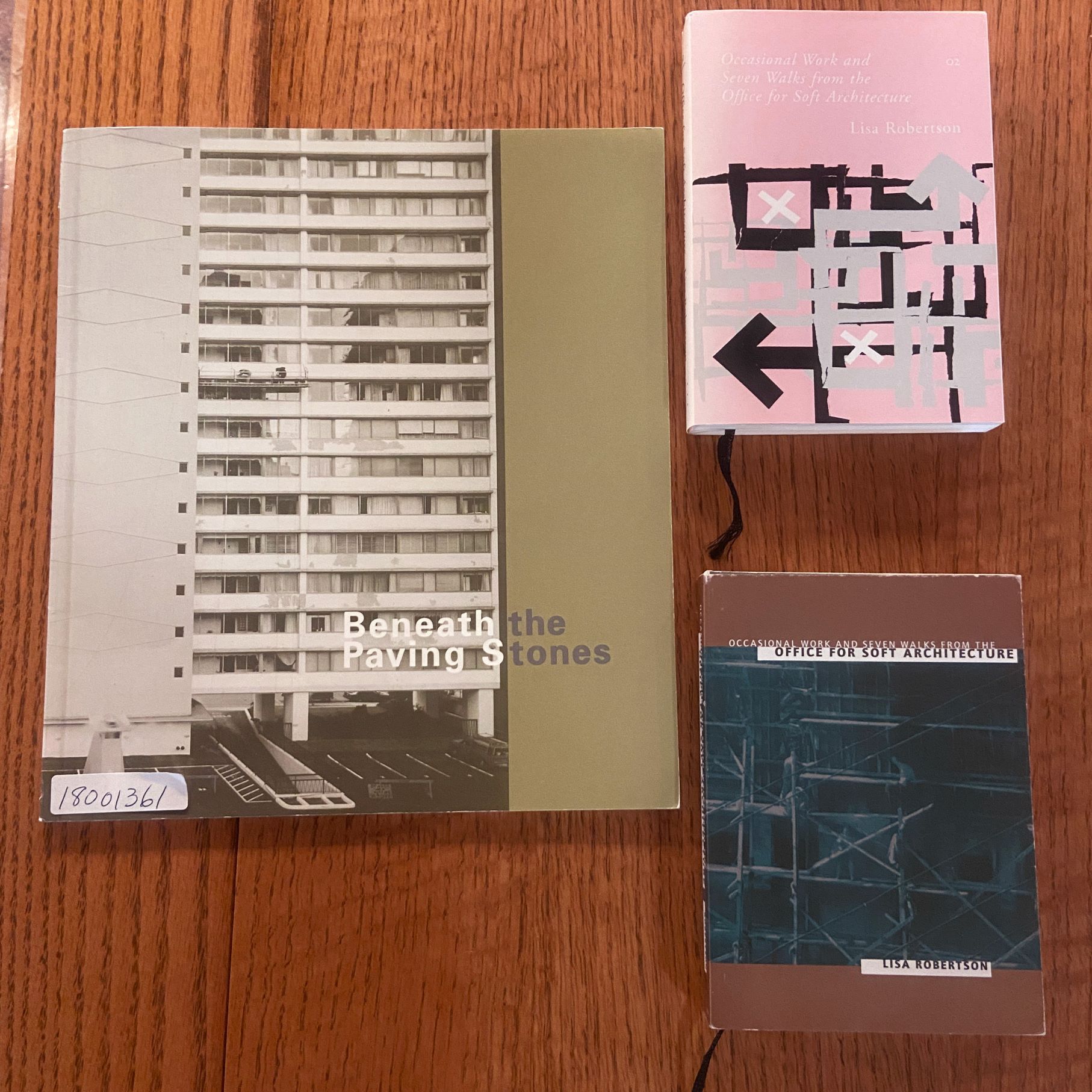
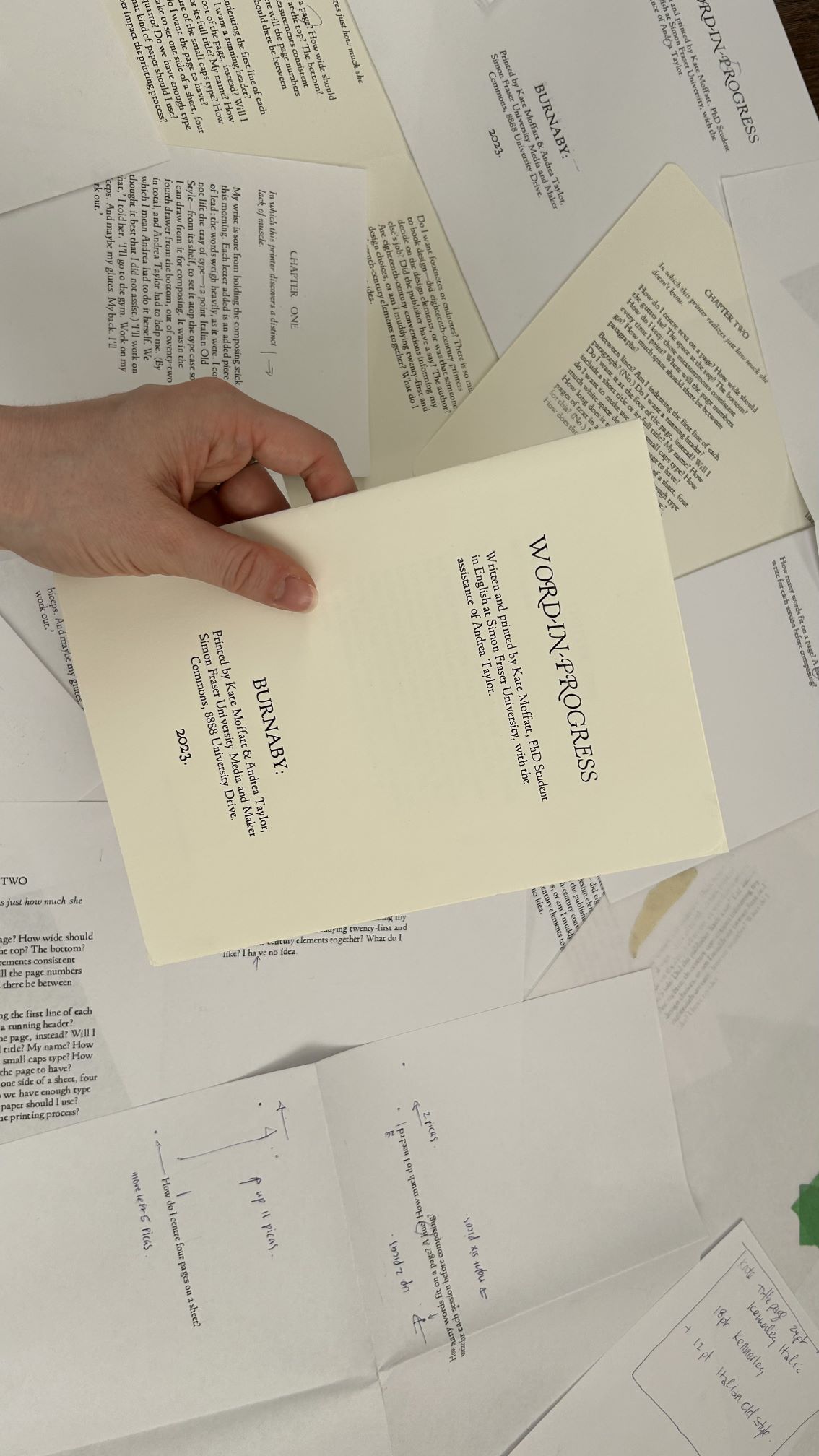
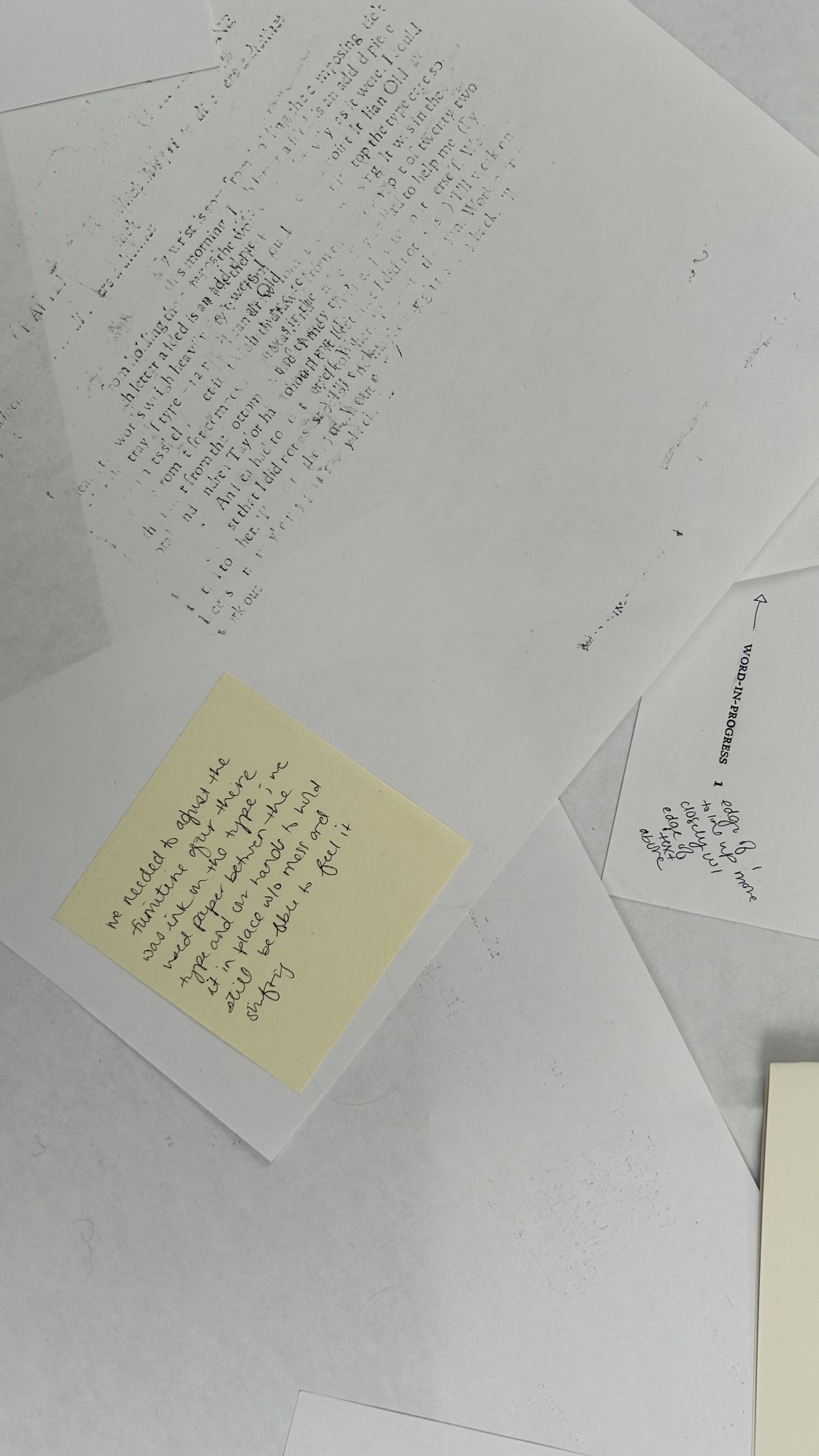
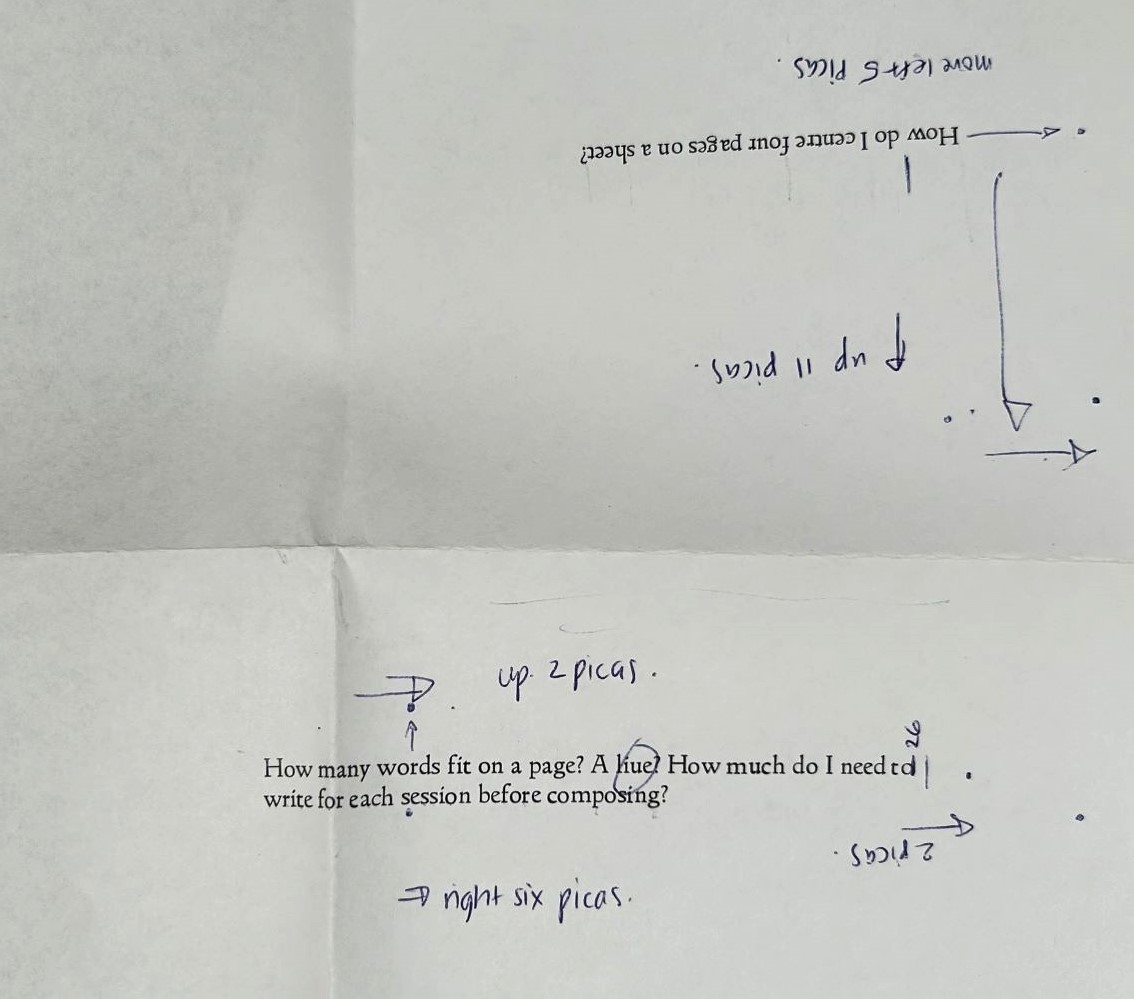
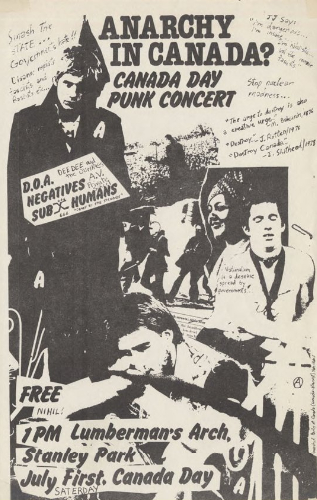
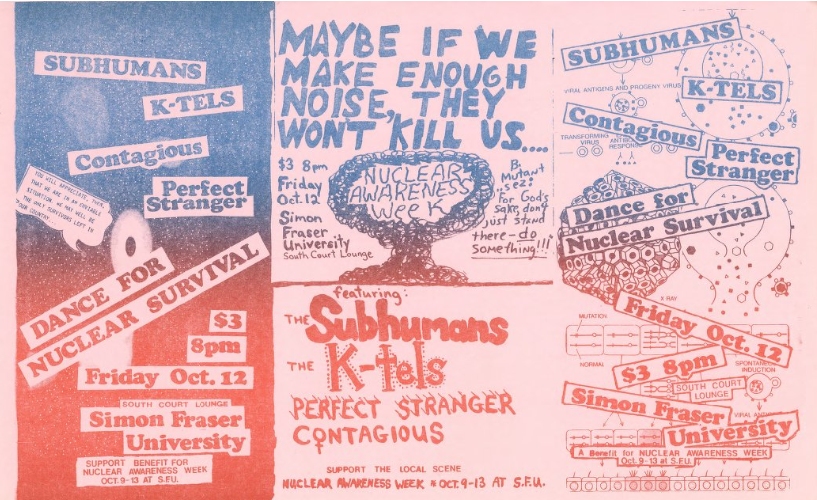
 From left to right:
From left to right: